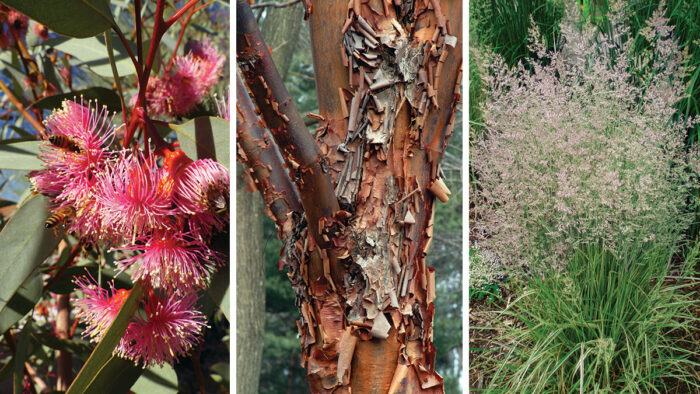
Designing a garden that shines year-round starts with choosing the right plants. Regional plants adapted to your climate not only thrive with less maintenance but also offer seasonal interest in every corner of your yard. From vibrant spring blooms to lush summer greenery, autumnal foliage, and striking winter textures, these plants ensure your landscape remains captivating throughout all four seasons. In this article, we’ll explore the best regional plants that bring beauty, resilience, and functionality to your garden, no matter the time of year.
| Jump to your region: | 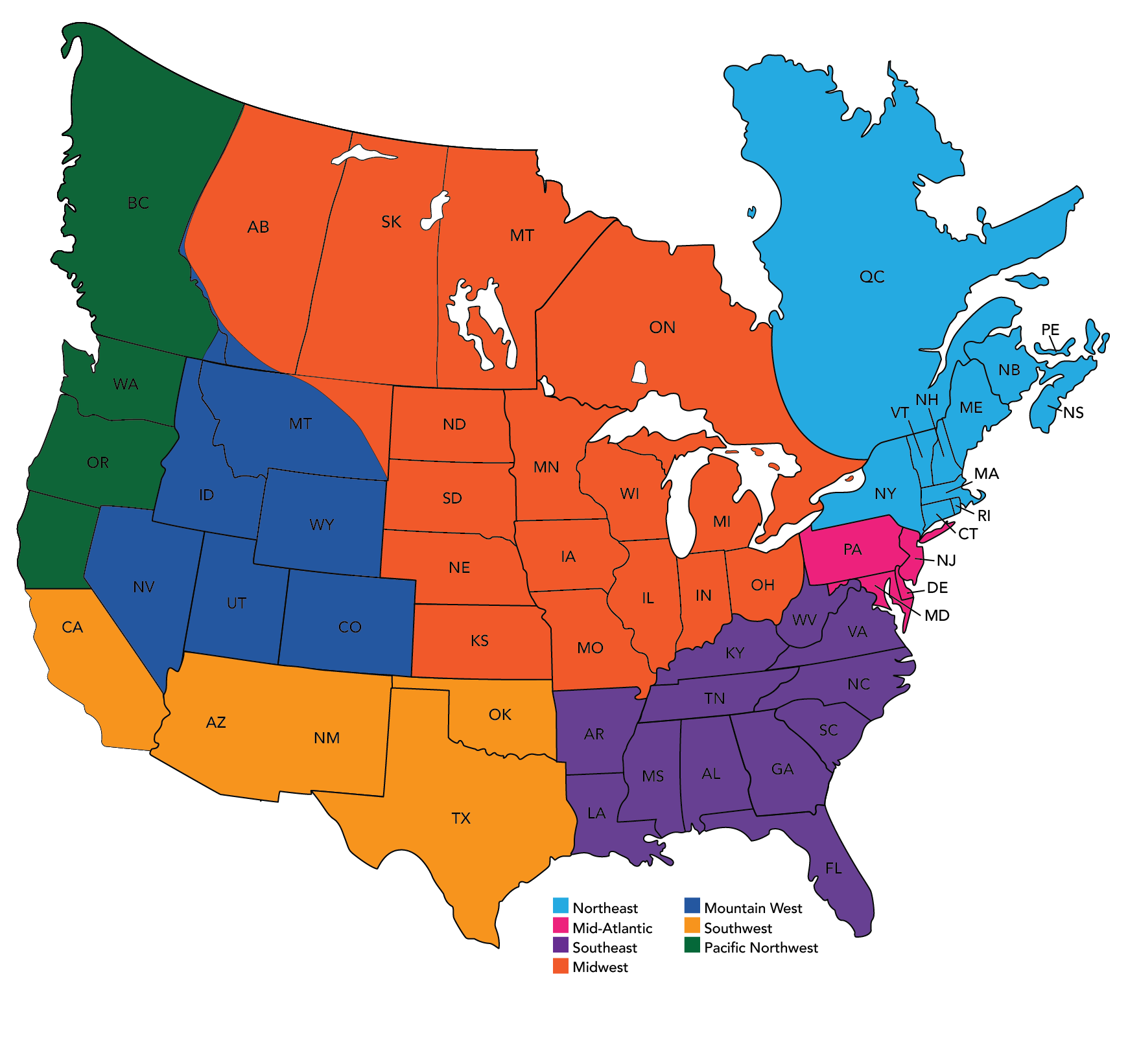 |
Pacific Northwest
Purple-Leaf Flase Holly
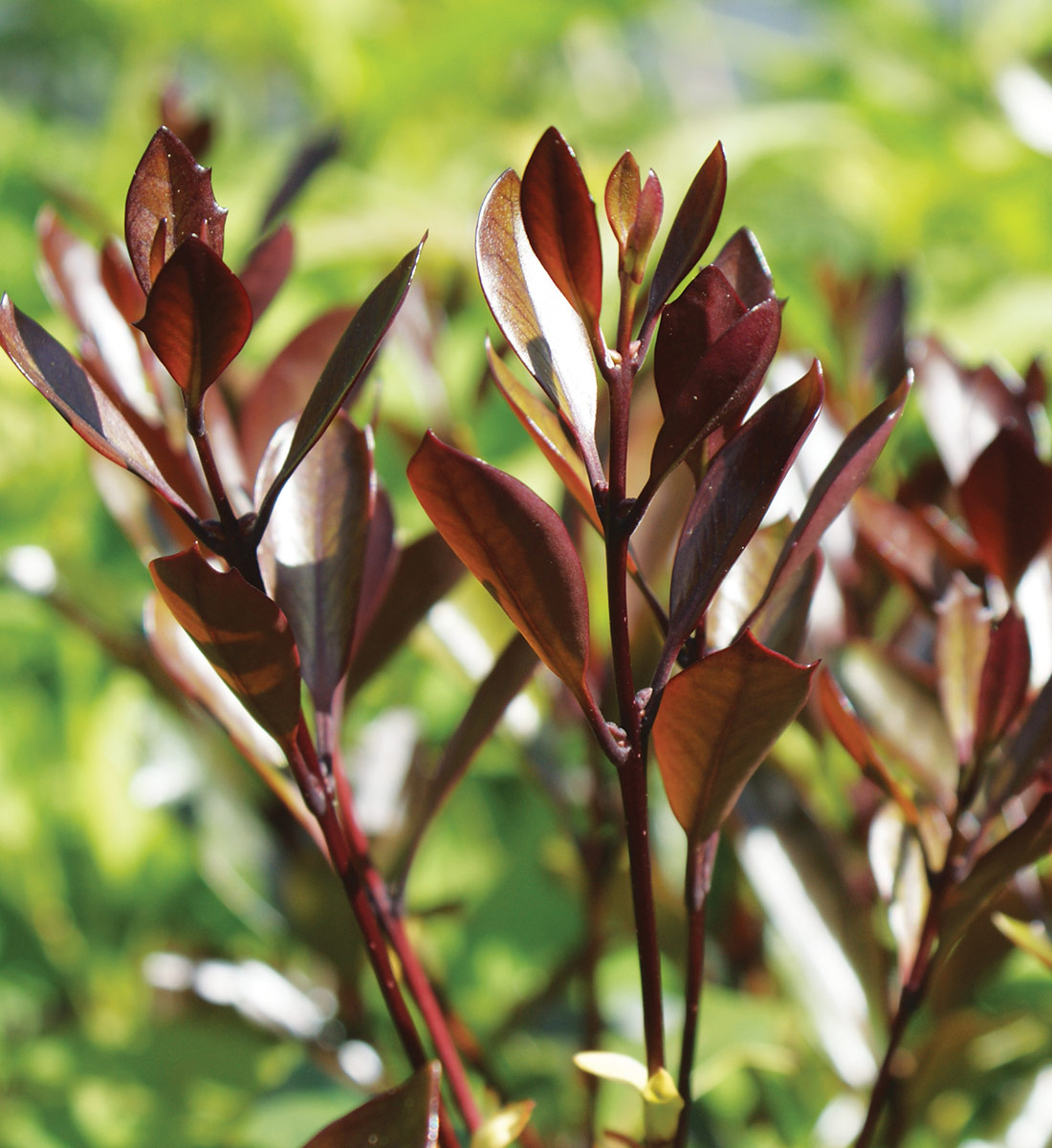
Name: Osmanthus heterophyllus ‘Purpurea’
Zones: 6–9
Size: 8 to 15 feet tall and 6 to 10 feet wide
Conditions: Full sun to partial shade; well-drained soil
Native range: Taiwan, Japan, and Korea
This beautiful evergreen has new growth that emerges a deep purple black (pictured). The small leaves, which look like those of a holly but are not prickly, settle to dark green in summer. A large, rounded shrub, this plant grows best in full sun or very light shade and is extremely well-adapted to tolerate drought once it is established. In October and November, mature plants bear masses of tiny white flowers that grow from the leaf axils and cast a sweet perfume throughout the garden. Purple-leaf false holly has excellent cold hardiness. It is great for use as a hedge or specimen and is easily kept at a smaller size. Since flowers occur on wood from the previous year, prune in winter after flowering, if needed.
‘Hillside Winter Gold’ Eastern White Pine
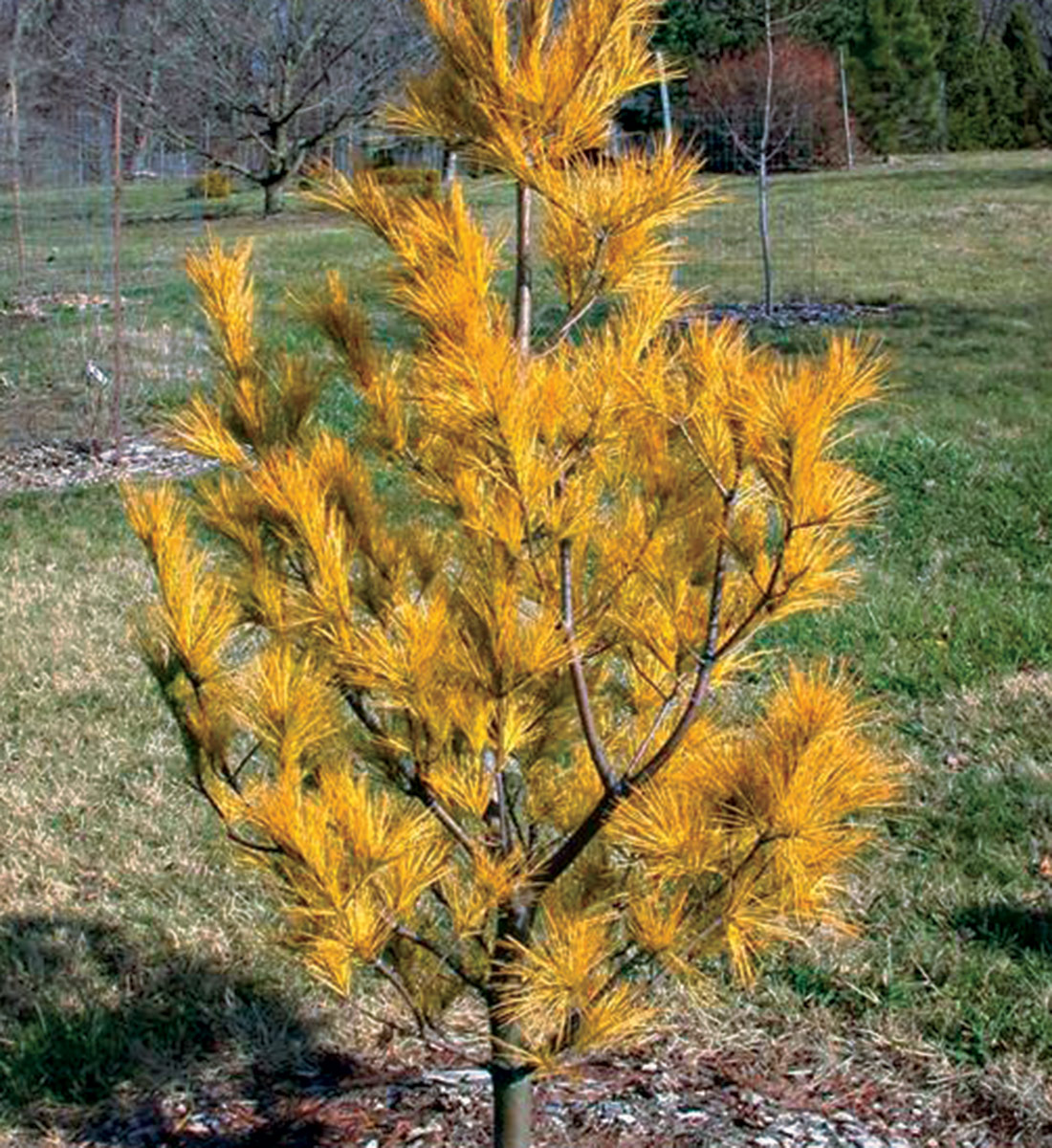
Name: Pinus strobus ‘Hillside Winter Gold’
Zones: 3–8
Size: 30 to 70 feet tall and 15 to 30 feet wide
Conditions: Full sun to partial shade; average, well-drained soil
Native range: Northeastern United States and southeastern Canada
This interesting selection of our native white pine goes through an extreme transition of yellowing needles in fall as the temperatures dip, and in the deep cold of winter the color shift continues to a golden yellow. The fine texture is a prized landscape feature throughout the year. Its golden foliage stands out with other conifers or in a mixed bed in any season. Siting ‘Hillside Winter Gold’ against a darker background of foliage will draw the eye toward this tree. It will reach 12 to 15 feet tall in 10 years but will eventually max out at up to 70 feet, so plan accordingly. As is the case with most conifers, good drainage is essential.
‘Glauca’ Spanish Fir
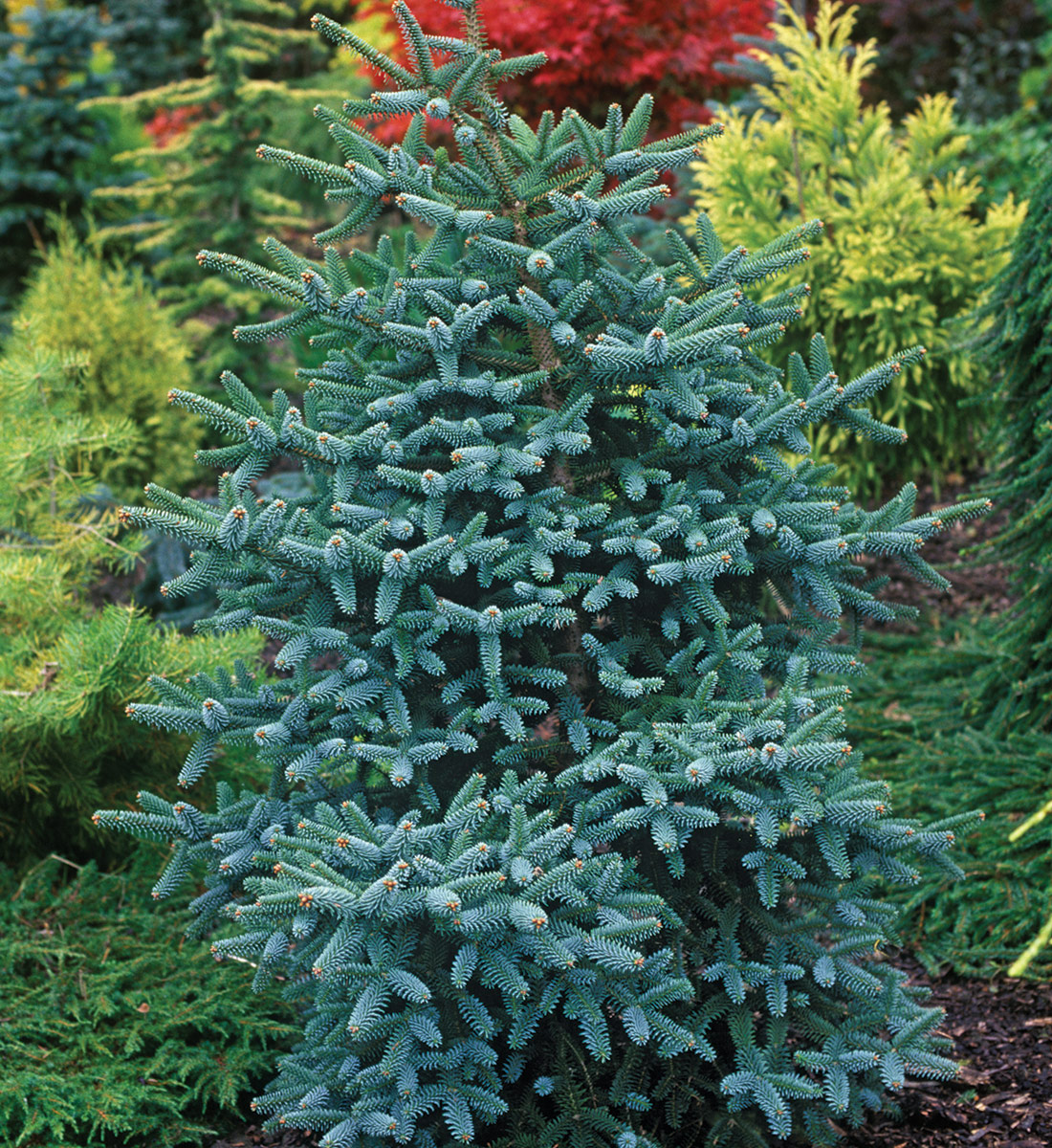
Name: Abies pinsapo ‘Glauca’
Zones: 6–9
Size: 15 to 30 feet tall and 7 to 15 feet wide
Conditions: Full sun; average to dry, welldrained soil
Native range: Spain and northern Morocco
The layered, pyramidal habit of this evergreen conifer provides a beautiful shape to the landscape. It has tight, powder blue foliage that invites touching, and in early spring the branch tips are covered with small, violet-red pollen cones, which stand out beautifully against the cool foliage color. The slow growth and disease resistance of ‘Glauca’ Spanish fir make it an excellent selection for urban plantings and other locations where space is limited. Whether it is used as screening or as a colorful focal point, it proves valuable to wildlife by creating excellent nesting habitat for birds. It is quite drought tolerant once established, and deer tend to leave it alone.
‘Fast Forward’ Pink Muhly Grass
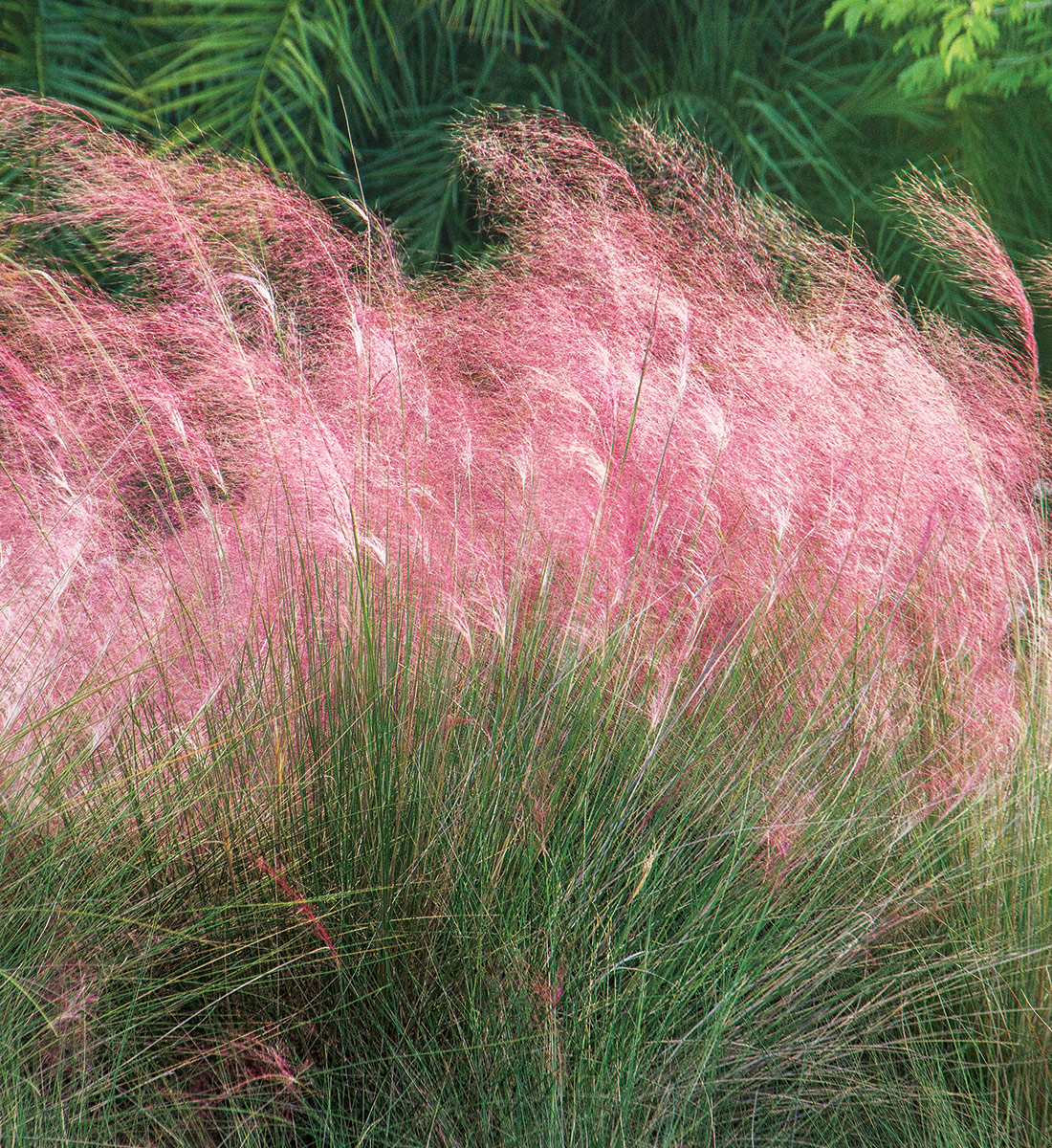
Name: Muhlenbergia capillaris ‘Fast Forward’
Zones: 5–9
Size: 30 inches tall and 48 inches wide
Conditions: Full sun; average to moist, well-drained soil
Native range: Southeastern United States
‘Fast Forward’ is one of the best low-growing evergreen grasses for any mixed border. The light green foliage is soft and moves gently in the slightest breeze. Its fall display is a jaw-dropping pink haze of seed heads that somehow goes perfectly with other autumn tints. It can take a wide range of growing conditions but colors up best in full sun. ‘Fast Forward’ pink muhly grass is an early, reliable fall bloomer that doesn’t seed around. Try to find a spot for it where it will be lit by low-angle autumn sunlight for the most spectacular effect.
Regional expert: Susan Calhoun is the owner and principal designer of Plantswoman Design in Bainbridge, Washington. She is also a Pacific Northwest regional reporter and forum moderator at FineGardening.com.
Southwest
‘Arizona Star’ Weber’s Agave
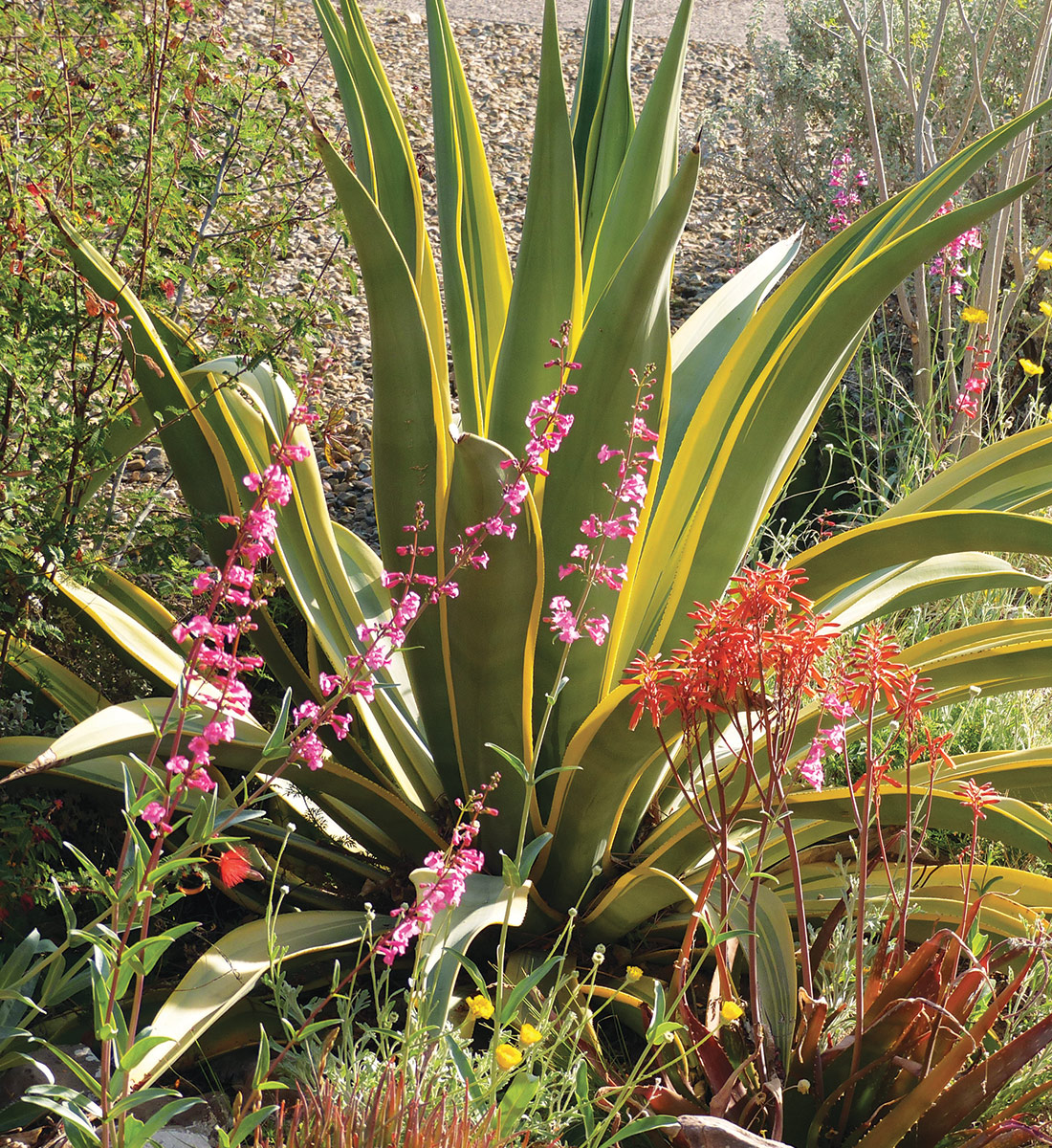
Name: Agave weberi ‘Arizona Star’
Zones: 8b–11
Size: 4 to 5 feet tall and 6 to 8 feet wide
Conditions: Full sun to partial shade; average to dry, well-drained soil
Native range: Northeastern Mexico and southern Texas
The first time I saw ‘Arizona Star’, its clean, gold leaf margins and lack of marginal teeth got my attention. Dubious about the projected mature size listed on the tag, I nonetheless gave it some elbow room. It wasted no time in filling the space, and over the next ten years it developed into a stunning specimen. Morning backlight illuminated its gold edges, and its leaf tips were a favorite perch for the resident Anna’s hummingbird. By year 12, a flowering spike shot up to 20 feet, nearly stopping traffic. Although its reign over the front garden was passing, ‘Arizona Star’ produced numerous pups, so the next generation is well on its way in new locations throughout my garden.
Coral Gum
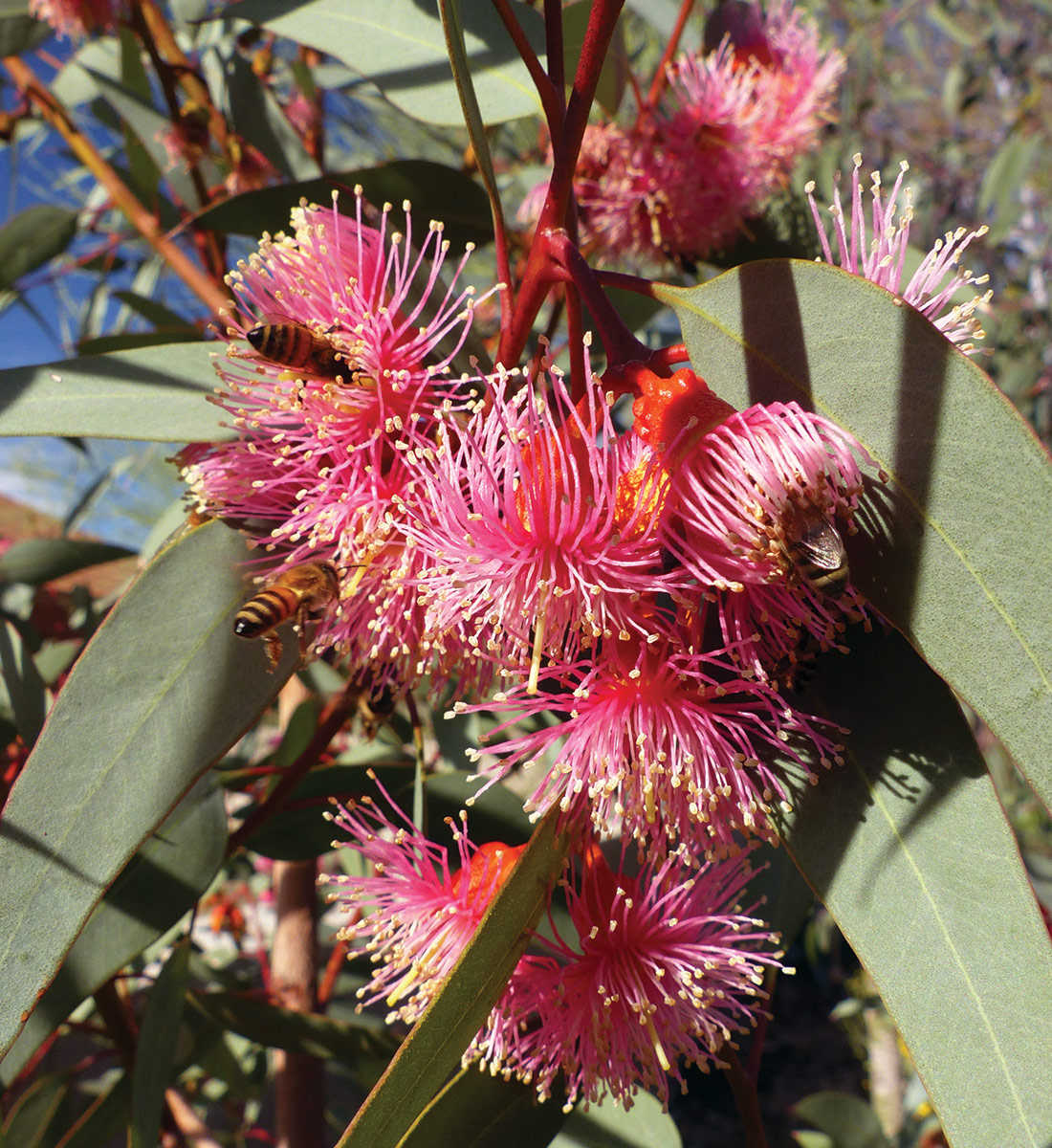
Name: Eucalyptus torquata
Zones: 8b–10
Size: 15 to 20 feet tall and wide
Conditions: Full sun; average to dry, well-drained soil
Native range: Goldfields region of western Australia
The smaller, flowering eucalypts have always intrigued me much more than the towering, overused giants. Unable to locate living trees, I grew my coral gums from seed. Within three years, they reached 6 feet tall and were already flowering. This durable tree tolerates wind, heat, and drought. Its evergreen crown is the perfect screen at the edges of my garden, but it serves as far more than a mere backdrop. Throughout the year, various trees will flower for up to eight weeks at a time, setting the garden perimeter aglow with shades of coral pink to rose red. The bountiful nectar-rich blooms bring in many bees, hummingbirds, and other pollinators.
‘Thunder Cloud’ Texas Sage
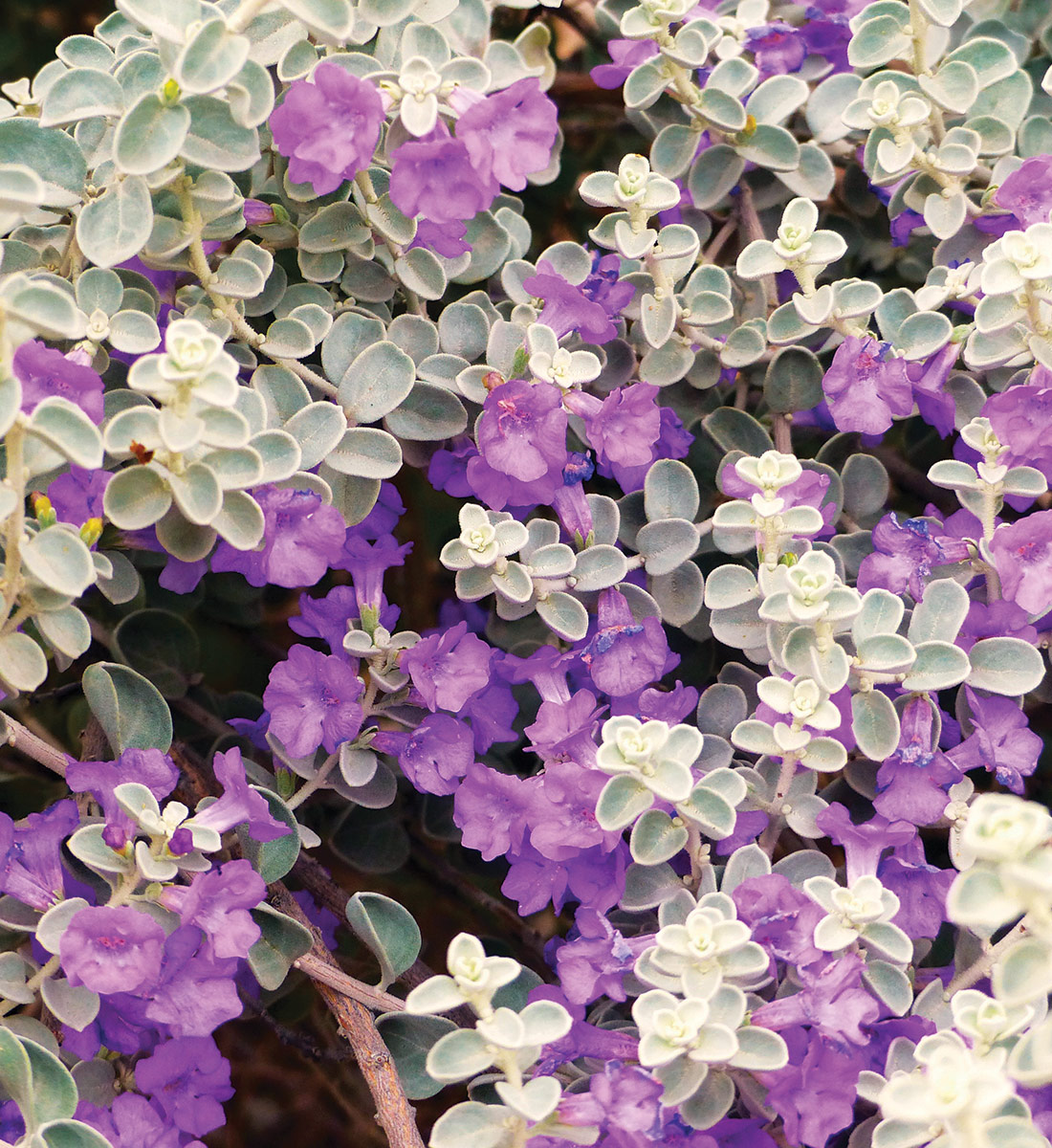
Name: Leucophyllum candidum ‘Thunder Cloud’
Zones: 8–10
Size: 3 feet tall and wide
Conditions: Full sun; average to dry, well-drained soil
Native range: From Nuevo Leon in Mexico to the Big Bend region of Texas
Commonly known as Texas Rangers, Leucophyllum shrubs range from 3 to 10 feet tall. ‘Thunder Cloud’ is a selection that tops out at 3 feet, its small, silver leaves providing soothing contrast to nearly everything else in the garden. Its mounded shape serves as a subtle anchor, not unlike a silver-gray boulder sitting quietly in the background—until monsoon season. Nearly every good summer rain is followed a few days later by a wave of clear, purple flowers that all but obscure the foliage. Pairing it with bird of paradise shrub (Caesalpinia gilliesii, Zones 7–10) will easily make high summer the most colorful time in your garden, their cooling tones a welcome recompense for the desert heat.
Texas Mountain Laurel
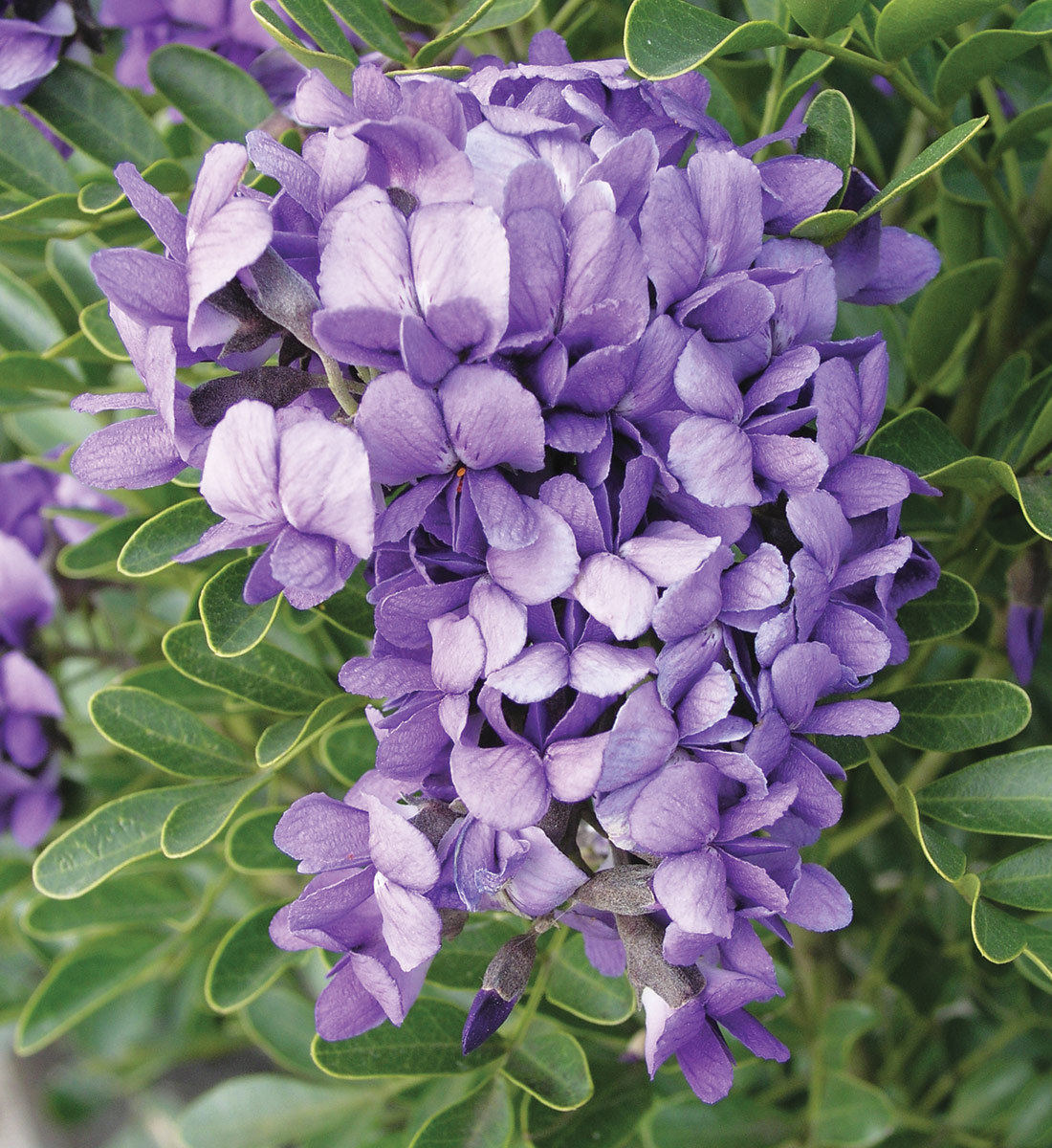
Name: Dermatophyllum secundiflorum (syn. Sophora secundiflora)
Zones: 7–11
Size: 10 to 20 feet tall and 8 to 12 feet wide
Conditions: Full sun; average to dry, well-drained soil
Native range: Texas, New Mexico, and northern to central Mexico
This small, robust tree boasts shiny evergreen foliage that is lush and dense all year. Slow to reach its mature size, it is ideal for a small garden or patio. The sculpted branches of mature specimens add great character. Its mid-spring blooms emit a fragrance with pleasant hints of grape soda. The flowers range from pale lavender to deep purple, held in bunches that may be compact to pendulous. Buy it when it is in bloom, from March to April, to choose the look you like best. Be aware that the colorful seedpods are toxic if consumed.
Regional expert: Dan Johnson gardens in Arizona and Colorado. He is associate director and curator of the native-plant collection at Denver Botanic Gardens and is a Southwest regional reporter and forum moderator for FineGardening.com.
Mountain West
Rocky Mountain Bristlecone Pine
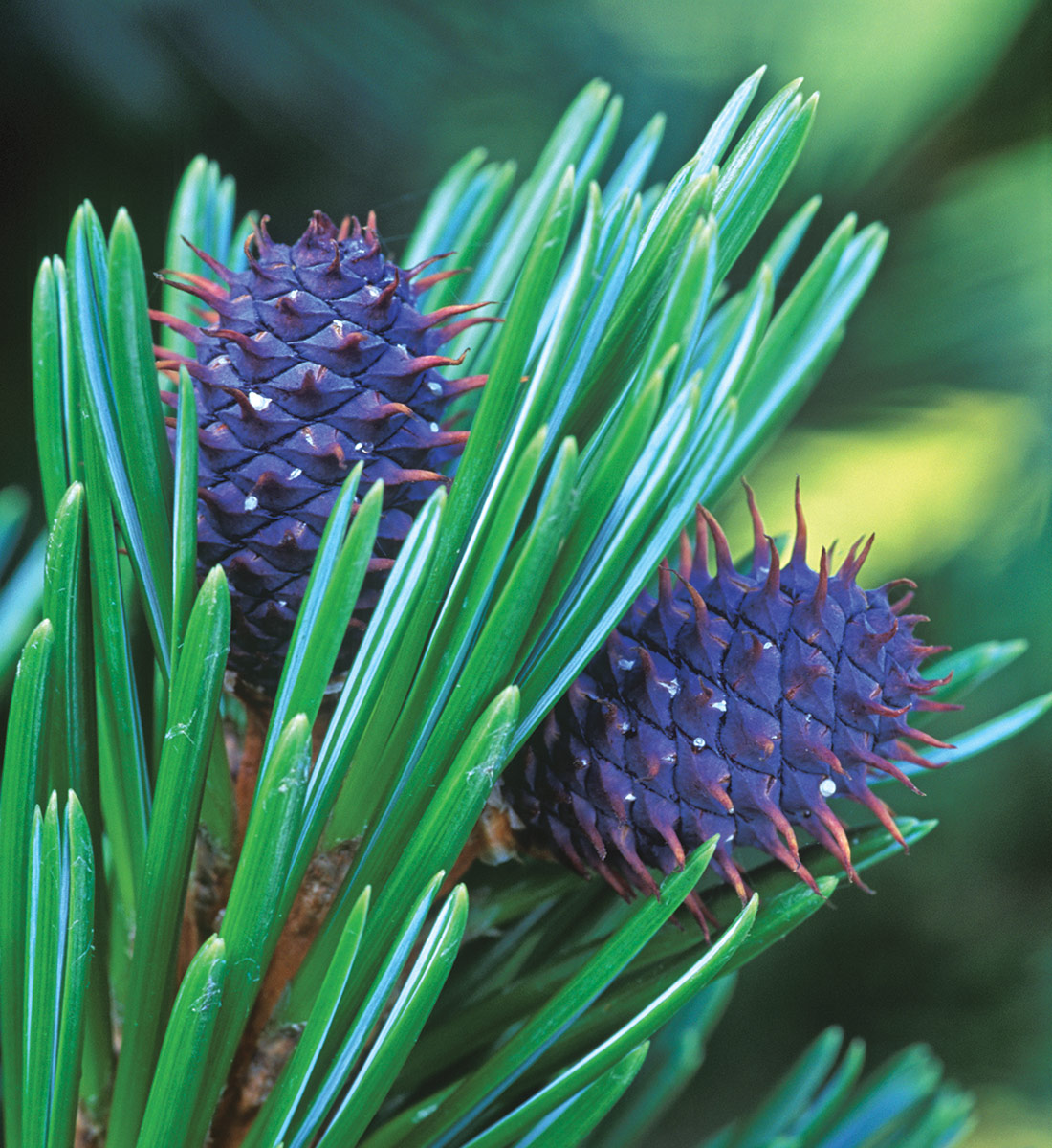
Name: Pinus aristata
Zones: 4–7
Size: 8 to 20 feet tall and 10 to 15 feet wide
Conditions: Full sun; dry, rocky, welldrained soil
Native range: Southern Rocky Mountains
A few Rocky Mountain bristlecone pines are confirmed to be over 2,500 years old, making them the oldest living plants in the world. Perhaps equally as impressive is their beauty in the face of the harshest conditions: severe heat, wind, cold, and drought. Their dark green needles grow in “packets,” or clusters of five, and may have tiny white dots (resin) on the needles. Typically, this tree will have a somewhat fluid form, with a twisted trunk that gradually tapers. The young pine cones are deep purple, which enables them to absorb extra sunlight. If you’re looking for a conversation piece in all 12 months, look no further.
Silverberry
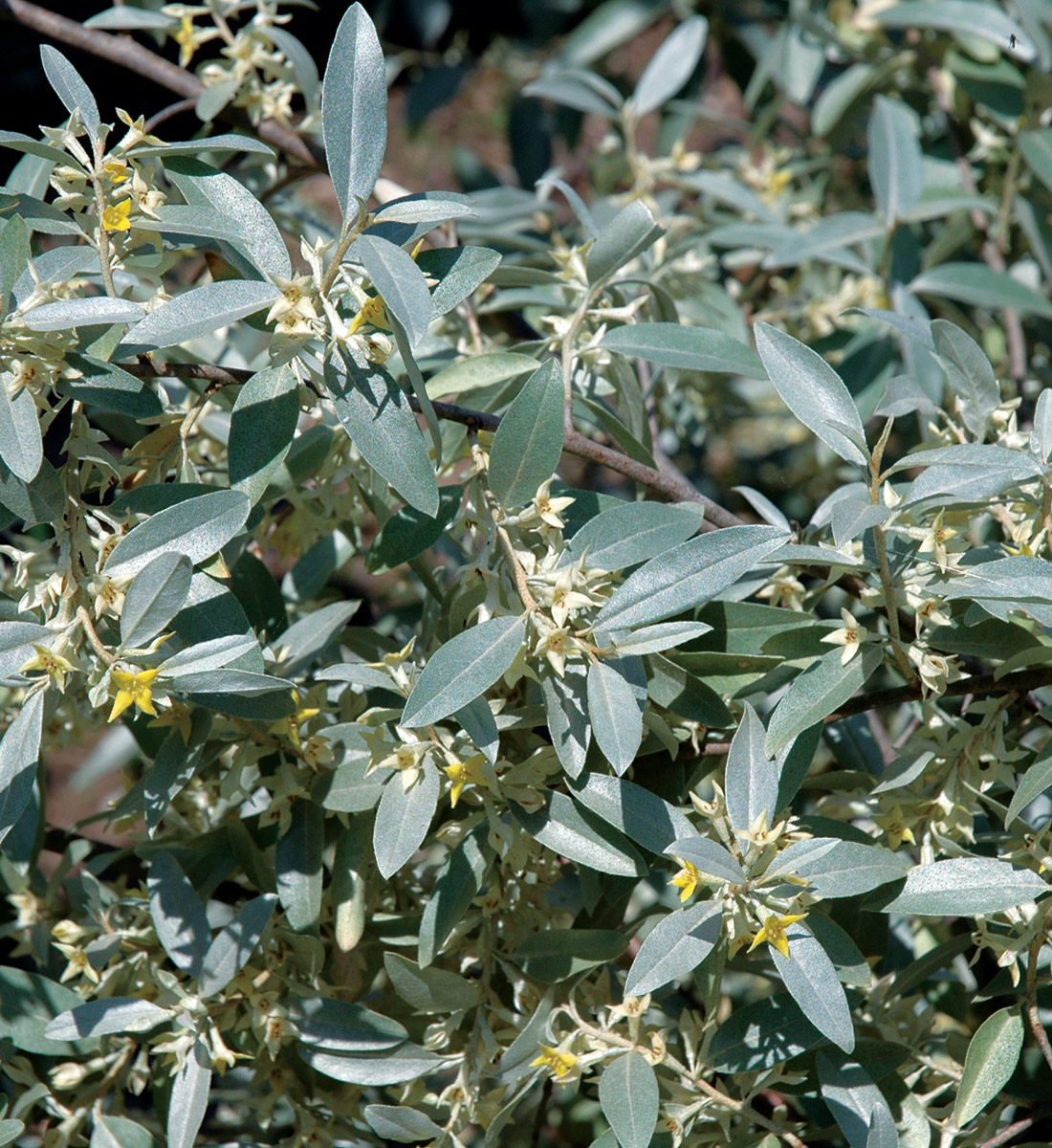
Name: Elaeagnus commutata
Zones: 3–6
Size: 3 to 5 feet wide and up to 12 feet tall
Conditions: Full sun to partial shade; well-drained soil
Native range: Western North America
A member of the olive family, this shrub has soft, malleable, furry, silver leaves. Its tiny, yellow, trumpet-shaped flowers may be difficult to see at first glance but emit a heady fragrance that can catch your attention from several feet away. Silverberry often keeps its leaves throughout winter, so it’s a plant I always put on my Fab Four Seasons list. This drought-tolerant shrub was used by indigenous people to make bead necklaces and to adorn clothing. It is a valuable food source for moose, elk, and deer, while providing habitat cover for passerine birds and mallard ducks. Don’t mistake it for the invasive Russian olive (E. angustifolia), which has a similar look but is not native.
Eternal Fragrance™ Daphne
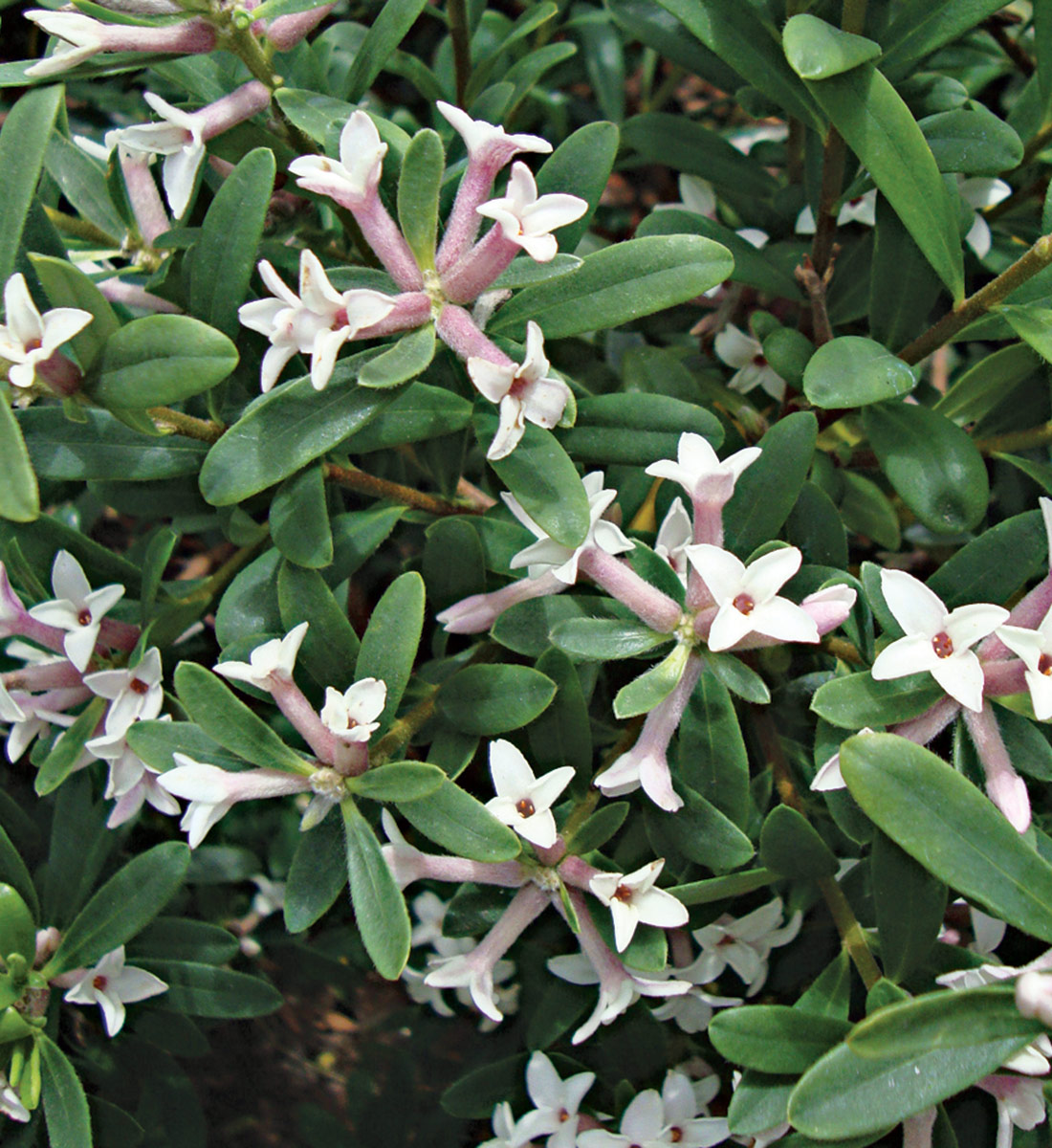
Name: Daphne × transatlantica ‘BLAFRA’
Zones: 6–9
Size: 3 feet tall and wide
Conditions: Partial shade; moist, well-drained soil
Native range: Hybrid
I would buy several of this daphne variety if I could find them. I’d even settle for just one at this point! For now, Eternal Fragrance™ is a tidy round shrub that I only get to enjoy in my neighbor’s garden. It’s perfect for planting near the front door because of its lovely fragrance—you can smell it before you see it. The handsome, shiny, dark green leaves contrast with the small white or rosy-pink flowers, and the branches are a lovely cinnamon color. This daphne is semievergreen, depending on the severity of the winter weather. It will do much better in our smoking-hot summers with a modest amount of supplemental water. Thankfully, deer don’t usually browse this shrub.
Rosy Pussytoes
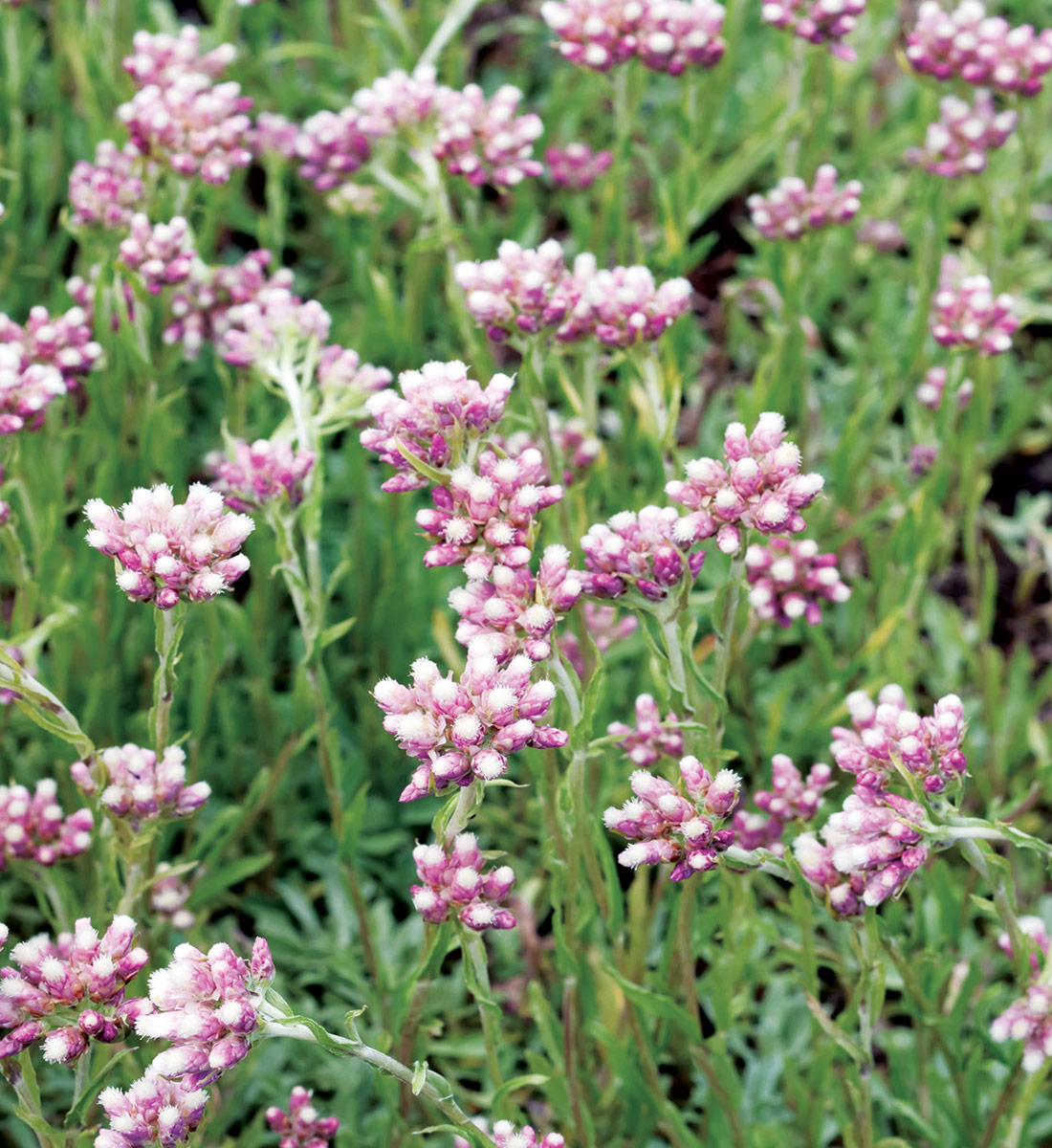
Name: Antennaria rosea
Zones: 3–9
Size: 8 to 10 inches tall and 1 foot wide
Conditions: Full sun; dry, well-drained soil
Native range: Western United States, the northern Great Plains, and Alaska
Widespread across the United States, rosy pussytoes is the showiest of the Antennaria genus. In the wild, it spreads in large lawn-sized patches in dry mountain regions. Underground rhizomes connect all the plants, creating one large ground cover. The short, gray semievergreen leaves quickly meld into a soft mat of silver. As the name implies, rosy pussytoes has red bracts around the fluffy, white “toes.” This is a host plant for the larvae of the American lady butterfly. When the blooms fade, shear them with a mower or clippers. It’s a perfect perennial for rock gardens and at the edge of paths.
Regional expert: Mary Ann Newcomer is a lifelong gardener based in Boise, Idaho, and the author of Rocky Mountain Gardener’s Handbook. She is also the Mountain West forum moderator for FineGardening.com.
Midwest
‘Overdam’ Feather Reed Grass
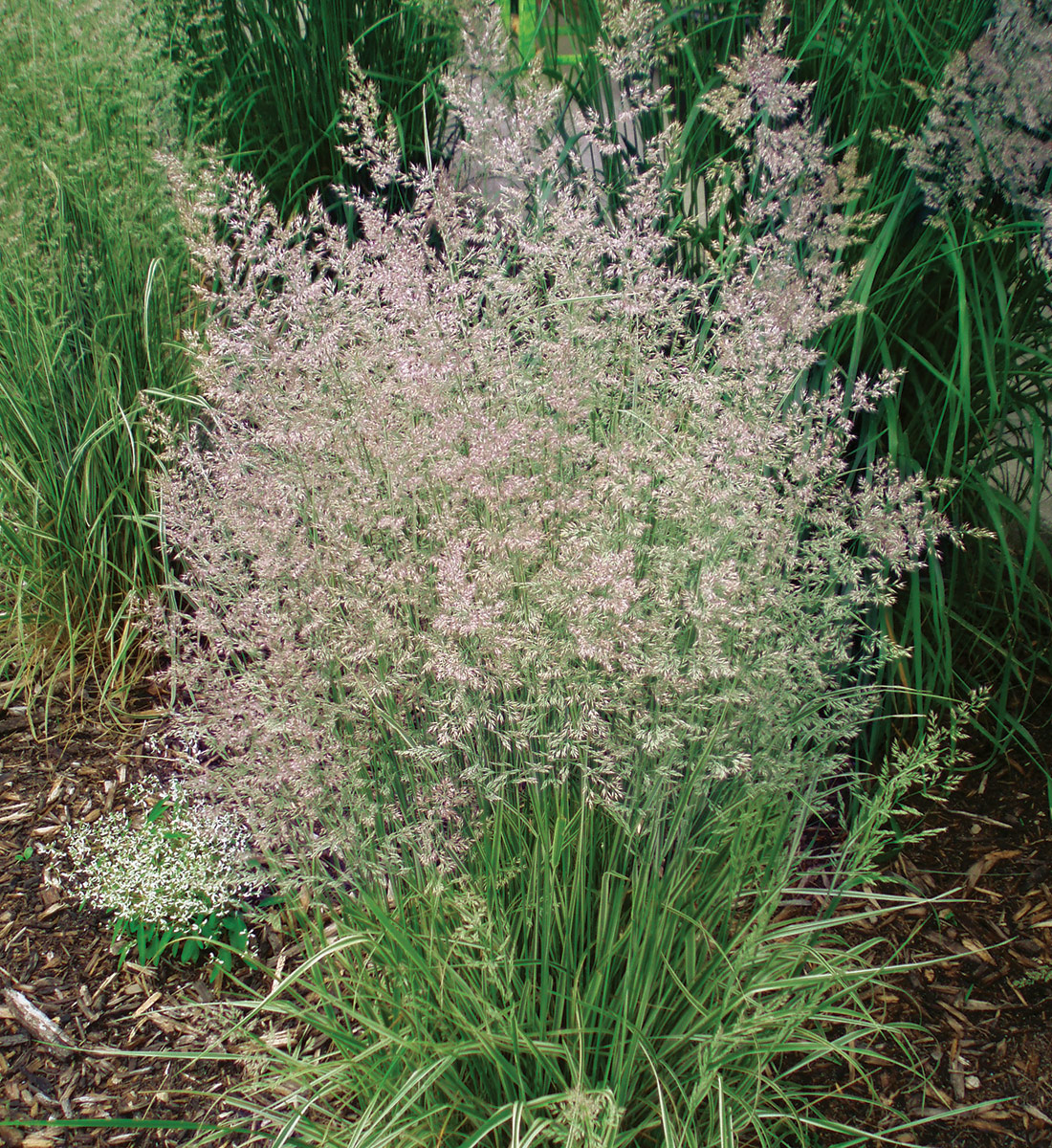
Name: Calamagrostis × acutiflora ‘Overdam’
Zones: 4–8
Size: 4 to 5 feet tall (in flower) and 2 feet wide
Conditions: Full to partial shade; tolerates a wide range of well-drained soil types
Naive range: Europe and Asia
This compact sport of the popular variety, ‘Karl Foerster’, features pronounced, creamy-white margins on a lower, clumping foliage mound. The crisp variegation (which can even reveal hints of pink) is best in climates with low humidity and cool summer nights. The stiff stems make this upright selection, which is carefree and versatile, perfect as an accent, in groupings, or even in mass plantings. The sturdy nature of ‘Overdam’ ensures that it always has a winter presence. Airy, pinkish-purple plumes arrive in early summer as this cool-season grass attains stature quickly and adds both form and movement to the landscape. This reliable and resilient variety is easy to divide and is also deer and rabbit resistant.
‘Sikes Dwarf’ Oakleaf Hydrangea
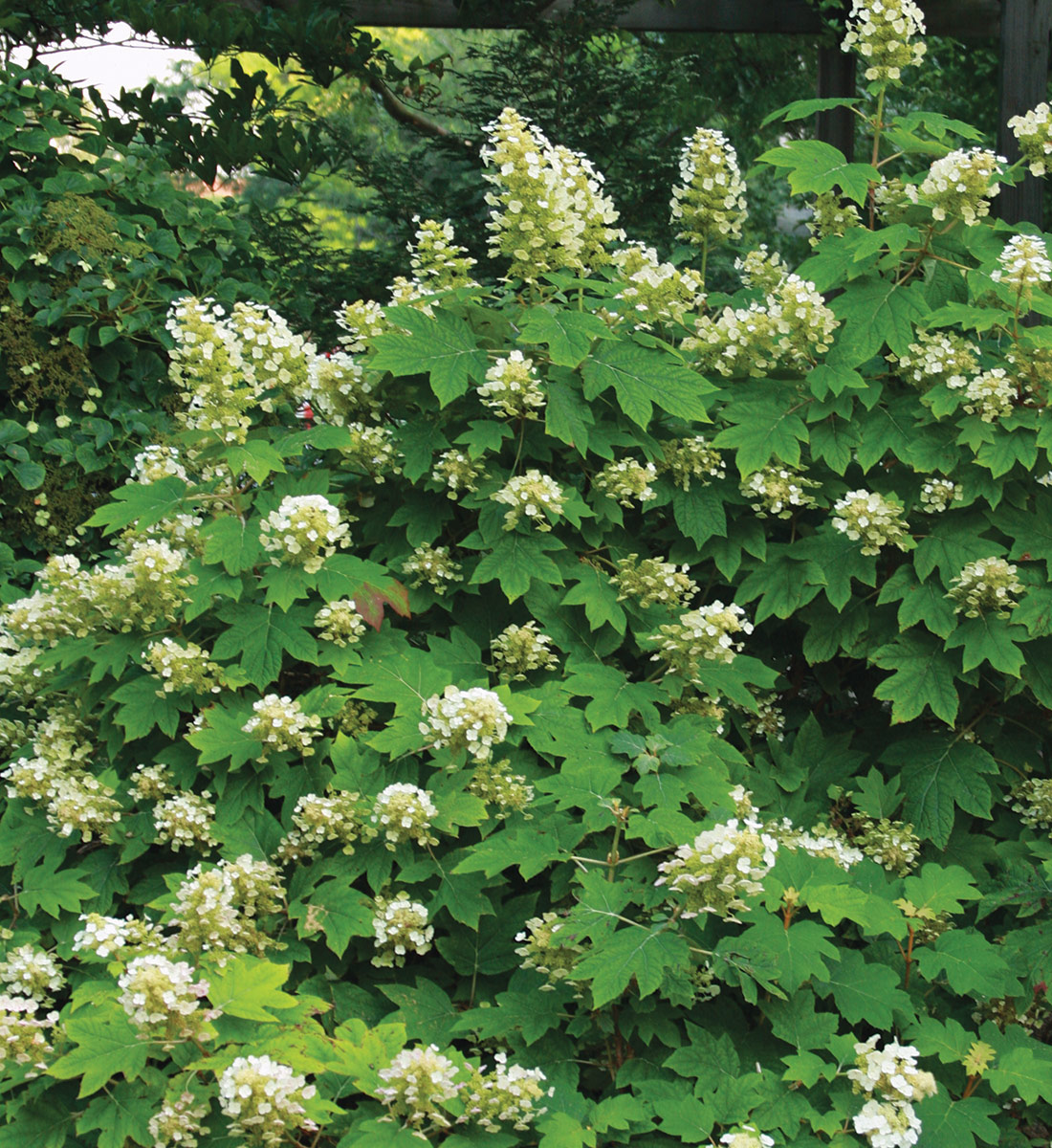
Name: Hydrangea quercifolia ‘Sikes Dwarf’
Zones: 5–9
Size: 3 to 4 feet tall and 4 feet wide
Conditions: Full sun to partial shade; rich, moist, well-drained soil
Native range: Southeastern United States
A compact, well-rounded, and well-branched selection of native oakleaf hydrangea, ‘Sikes Dwarf’ packs in all the same seasonal interest as larger varieties. While the foliage is smaller than full-sized selections, this diminutive cultivar still features deeply lobed, oak-shaped leaves that will turn scarlet to burgundy in autumn. The white, cone-shaped flowers in summer age to pink, and the interesting dried panicles persist throughout the winter months. The bark on older stems exfoliates and becomes furrowed over time, which offers noticeable winter interest. Adequate moisture and good drainage are a must for the success of this heavy-blooming variety.
Thick-Stemmed Wood Fern
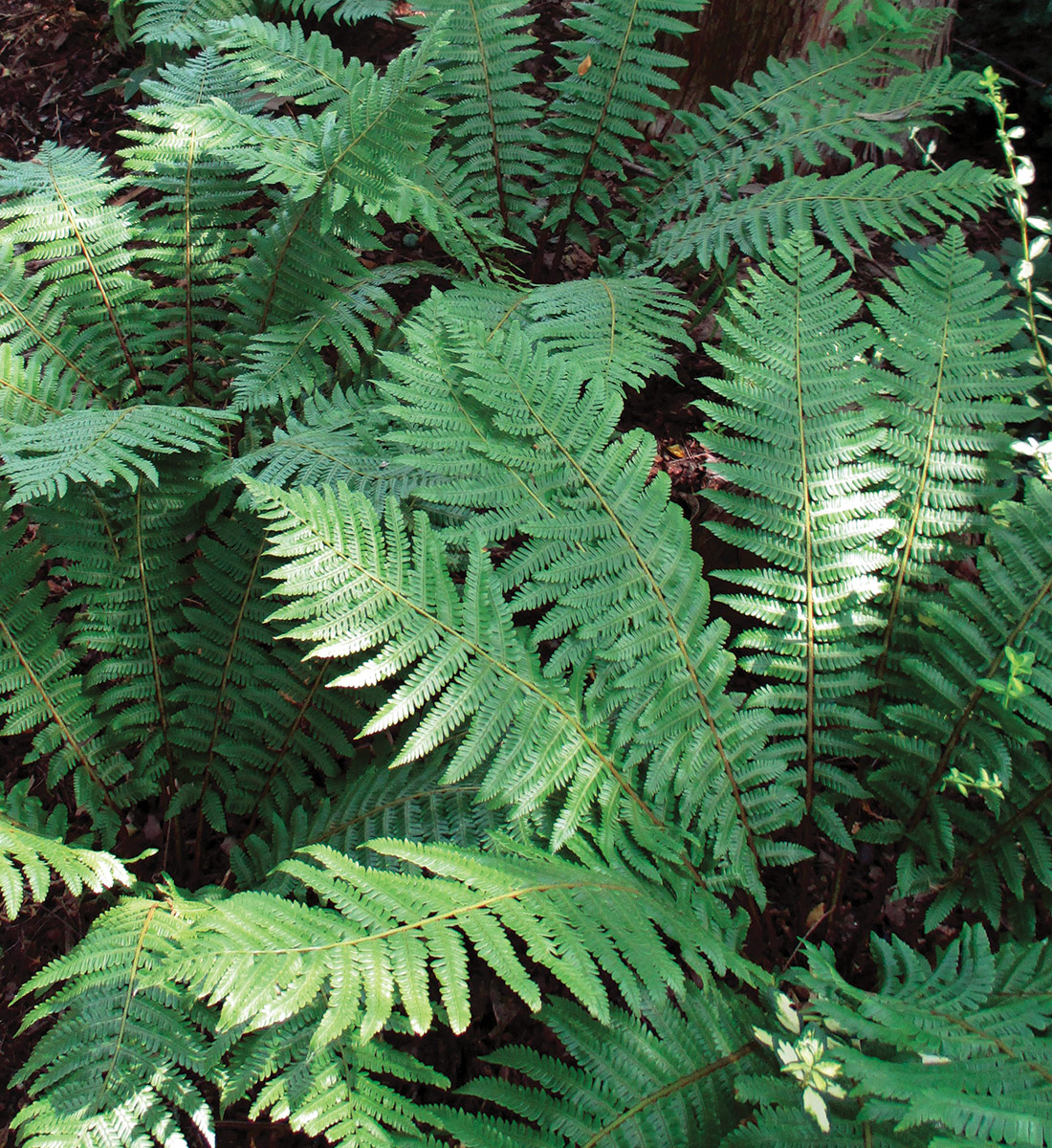
Name: Dryopteris crassirhizoma
Zones: 4–8
Size: 40 inches tall and 36 inches wide
Conditions: Partial to full shade; moist, organic soil
Native range: Northeastern Asia
This vase-shaped, semievergreen fern offers a lengthy, subtropical look with stout and erect growth arranged in a symmetrical helix. I’ve observed the same patch of a dozen of these ferns for 20 years in the Midwest and am always amazed at the robust growth, mature size, and extended evergreen appearance. It even stays rigid and upright until the snow flies (then flattens out and can be cleaned up in late winter). The solitary crowns appear as a semiwoody base covered in long brown scales, and the frond color is a deep shade of green. Deer resistance is a bonus. Thick-stemmed wood fern is consistently excellent over the entire growing season and beyond.
Neon Burst™ Tatarian Dogwood
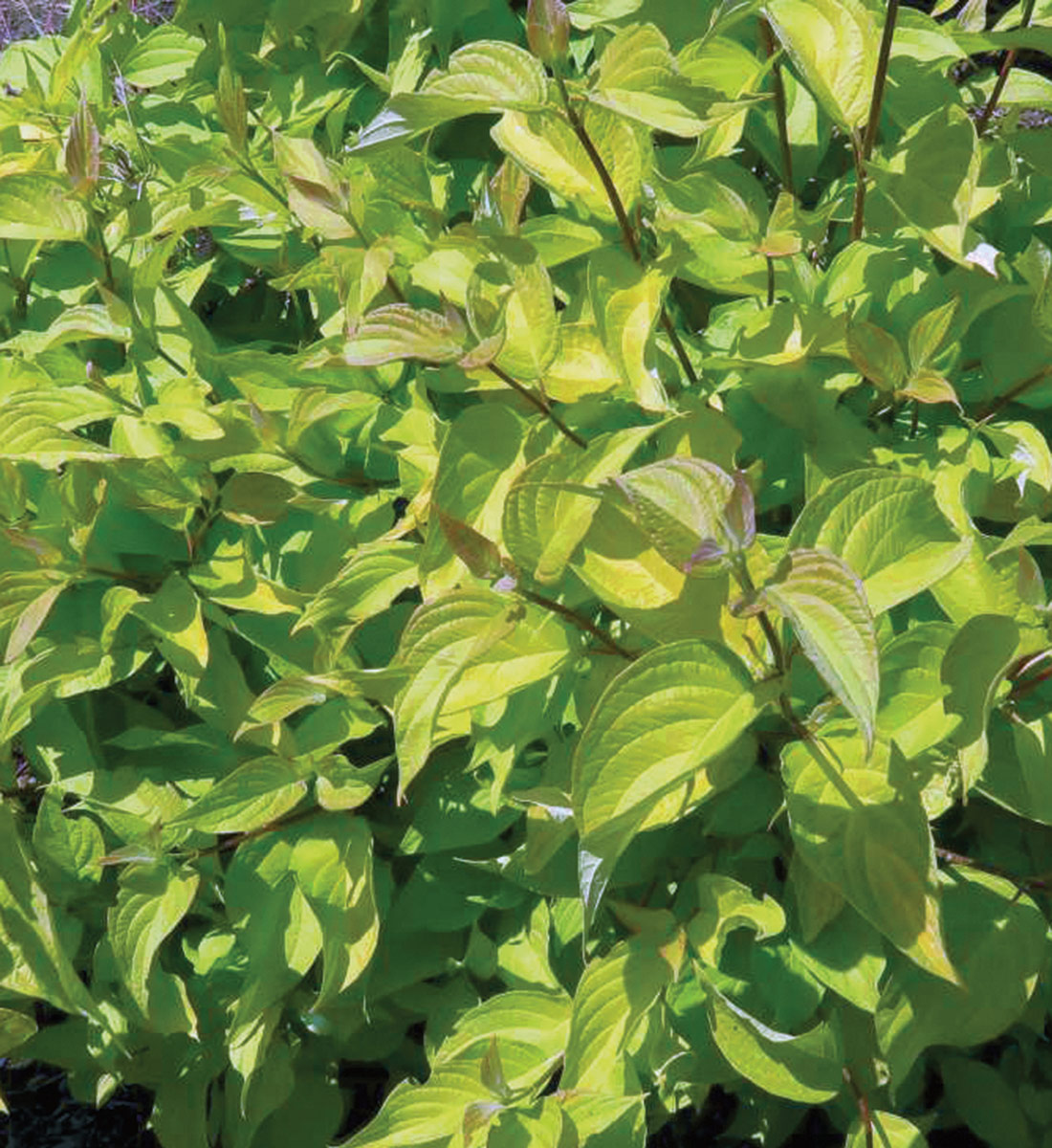
Name: Cornus alba ‘ByBoughen’
Zones: 2–7
Size: 4 to 6 feet tall and wide
Conditions: Full sun to partial shade; moist, fertile soil
Native range: Eastern and central Asia
I’ve grown other golden-leaved dogwoods, but this compact selection has consistently impressed me with scorch-resistant yellow foliage that holds up in the hot summer months, eventually fading to a decent chartreuse. Creamy-white flower clusters are a spring bonus, but it’s really the bright leaves that make this variety a beacon out in the landscape. Fall colors can include purple, red, yellow, and orange. The bold, glossy red stems become an even deeper shade of scarlet in winter and offer vivid color until spring arrives. With an upright to rounded habit, Neon Burst™ is heat and drought tolerant and resistant to both deer and rabbits.
Regional expert: Mark Dwyer manages the Edgerton Hospital Healing Garden in Edgerton, Wisconsin, and operates Landscape Prescriptions by MD. He is also a regional reporter and forum moderator for FineGardening.com.
Southeast
Chinese Parrotia
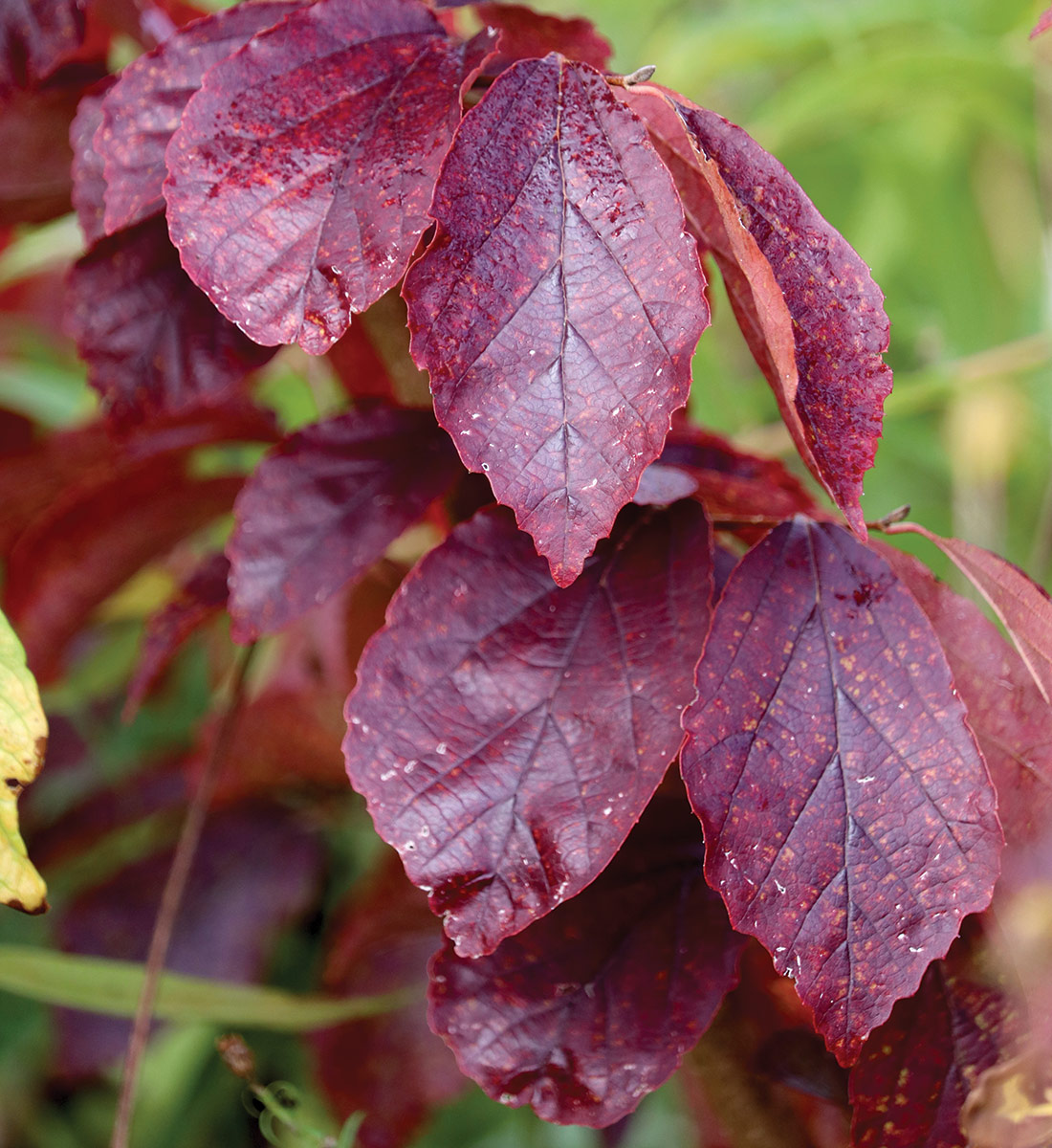
Name: Parrotia subaequalis
Zones: 6–8
Size: 15 to 25 feet tall and wide
Conditions: Full sun to partial shade; average to rich, well-drained soil
Native range: China
This striking deciduous tree is known for its fall foliage and handsome form. It is somewhat difficult to find in nurseries and rare in its native habitat, but has made its mark with collectors due to its year-round appeal. Chinese parrotia’s most outstanding feature develops in late fall, when the oblong, rounded leaves turn from medium green to brilliant shades of deep red or, more often, nearly black purple. My young plants have fairly smooth bark, but I understand that with age the trees will develop unique mottled bark that peels away in jigsaw patches, adding winter interest. Of course, it likes fertile, well-drained soil, but I have found it can tolerate leaner conditions.
‘Sunny Foster’ Holly
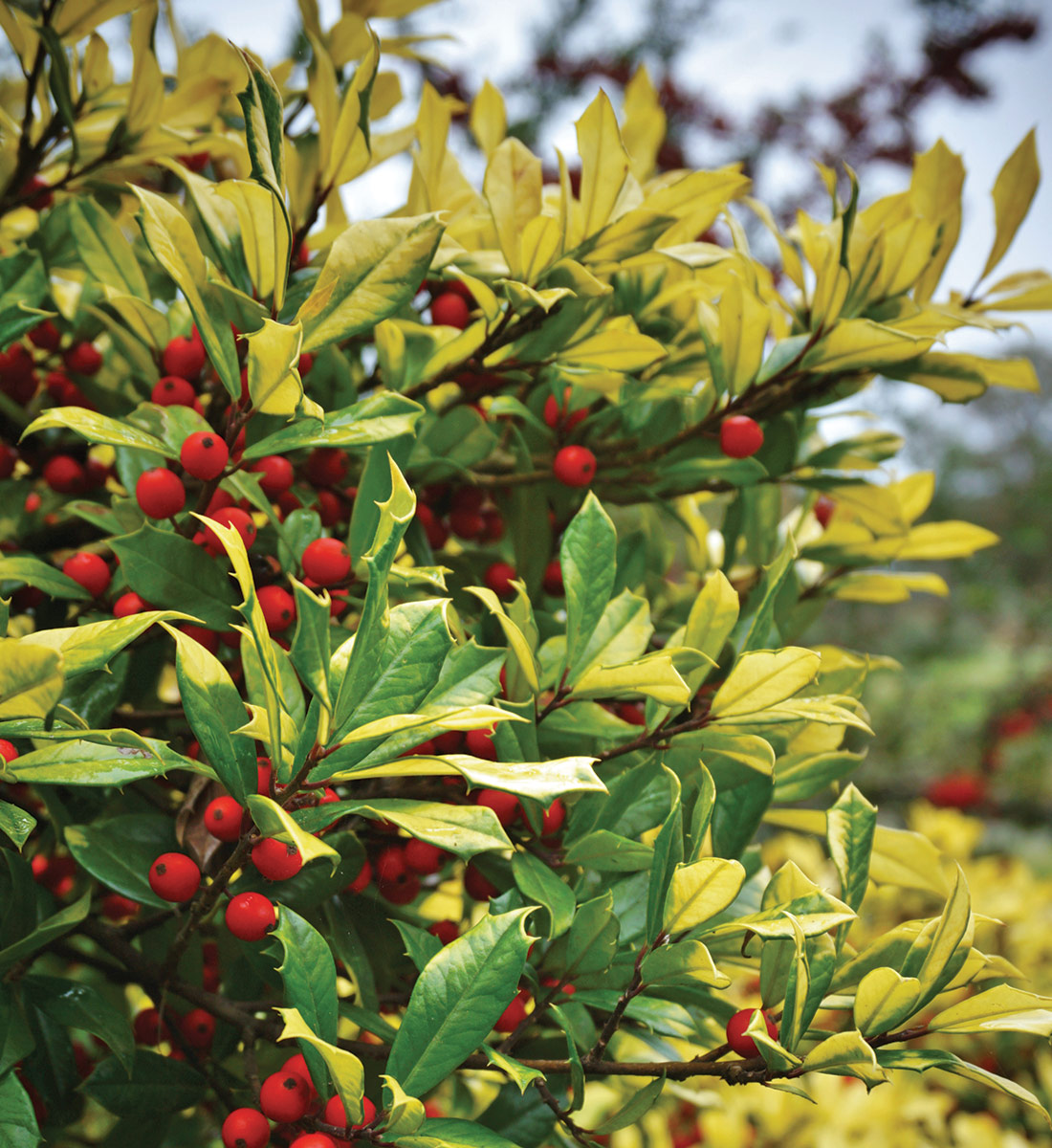
Name: Ilex × attenuata ‘Sunny Foster’
Zones: 7–9
Size: 25 to 30 feet tall and 12 to 20 feet wide
Conditions: Full sun to partial shade; well-drained soil
Native range: Southeastern United States
‘Sunny Foster’ holly is renowned for its dense foliage and leaves that look like they were dipped in gold. This plant was discovered as a variegated leaf mutation on ‘Foster No. 2’ and has a similar growth habit to its parent plant. It produces small, white flowers in spring followed by abundant, late-season red berries, even without a male pollenizer nearby. It’s ideal as a single specimen; an uncrowded plant will truly show off its stately form. Pruning can be done to maintain shape and size, especially after the berry display. This cultivar is noted for its hardiness and is relatively pest-free. ‘Sunny Foster’ was the 2006 American Holly Society holly of the year and is a hybrid of two native hollies (I. cassine and I. opaca).
Hairy Alumroot
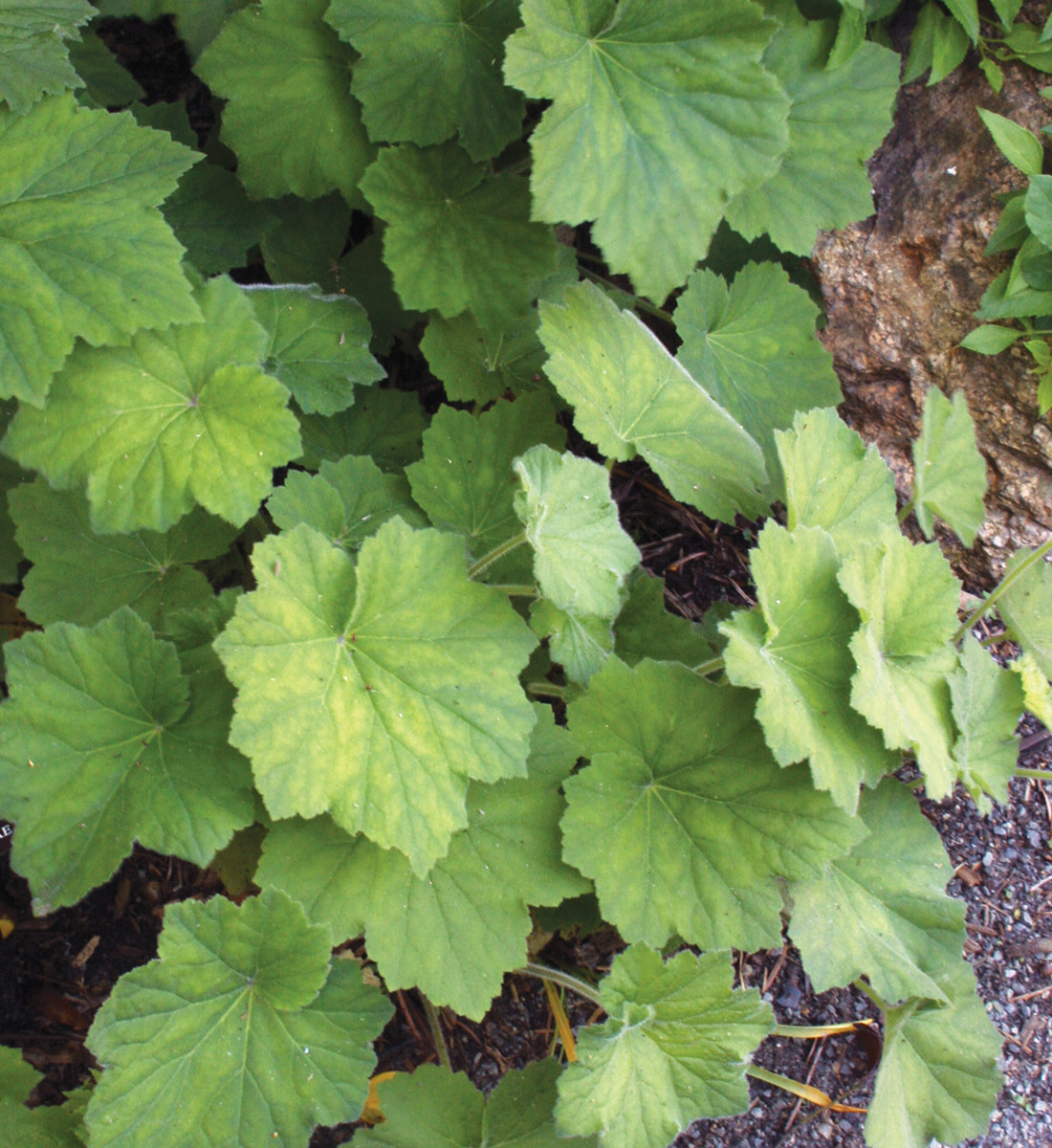
Name: Heuchera villosa
Zones: 4–9
Size: 12 to 18 inches tall and wide
Conditions: Partial to full shade; average to moist, well-drained soil
Native range: Eastern United States
Hairy alumroot is a versatile perennial prized for its attractive foliage and shade tolerance. I’ve seen this tough plant growing in its native habitat in a spoonful of soil in the crack of a rock. Good garden soil is not required, but it looks especially lush growing in loose organic soil with some moisture. This plant features rounded green leaves with a hairy texture that catches the light. It produces small, delicate flowers on slender stalks in late spring to early summer. Hairy alumroot is ideal for shaded garden beds and woodland areas. Regular deadheading of the flower stems will encourage a tidy appearance and prolonged bloom time.
Bad Hair Day Mondo Grass
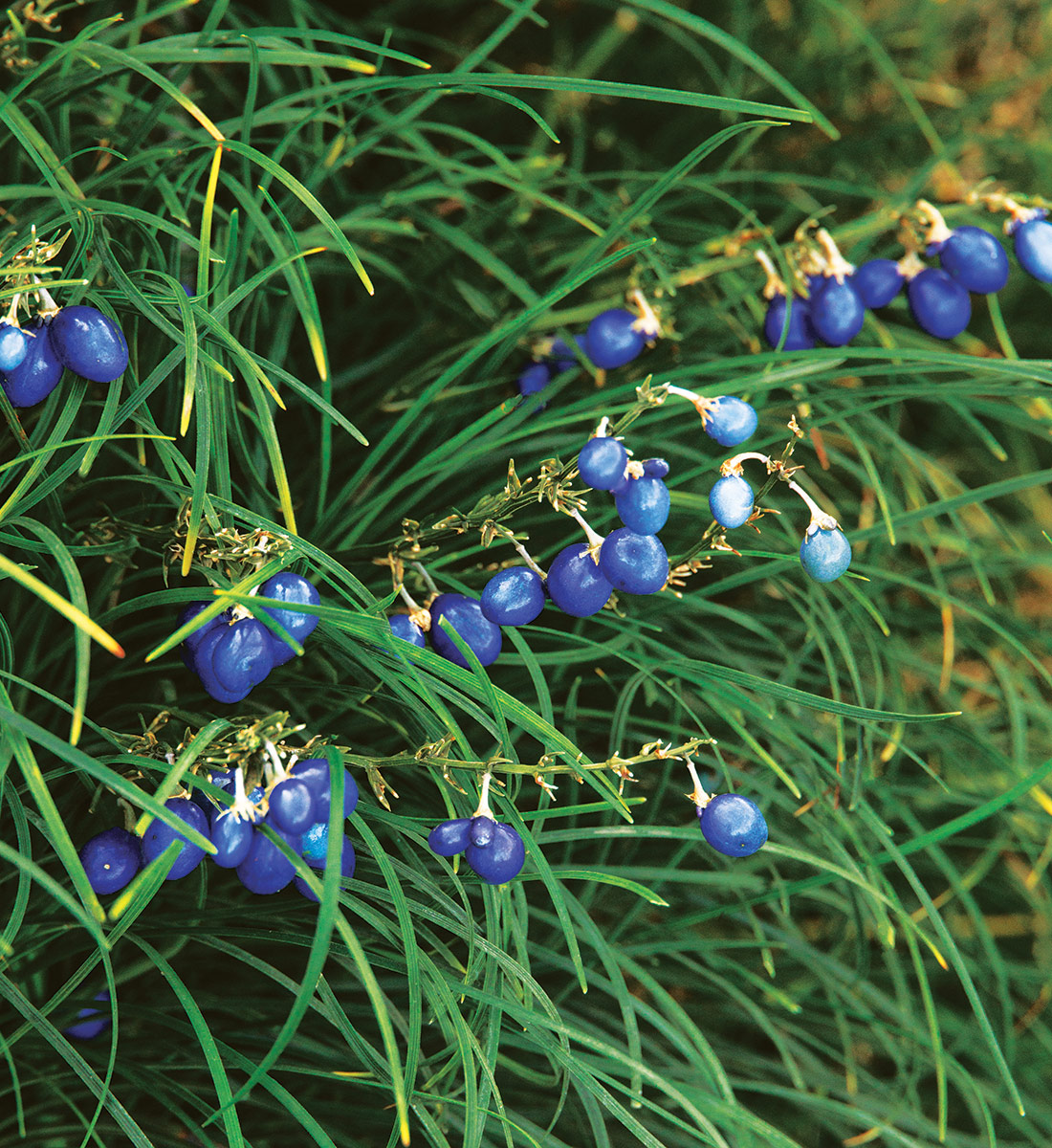
Name: Ophiopogon umbraticola
Zones: 6–10
Size: 6 to 10 inches tall and 12 to 18 inches wide
Conditions: Partial to full shade; rich, well-drained soil
Native range: China
“Bad hair day” is the perfect description of the effect you get with this plant. A striking ground cover with dark foliage, this evergreen perennial is valued for its dramatic appearance and versatility in shady or lowlight garden areas. It forms a dense mat of slender, arching leaves and produces small, inconspicuous, white flowers in late summer, followed by electric black to blue, pearl-like berries that add visual interest. Minimal maintenance is required. Ideal for adding texture to shaded garden beds or as an accent plant in shady mixed containers, this is also my top choice for a turfgrass alternative under trees.
Regional expert: Andy Pulte, PhD, is a faculty member in the plant sciences department at the University of Tennessee in Knoxville, and a Southeast regional reporter and forum moderator on FineGardening.com.
Mid-Atlantic
Paperbark Maple
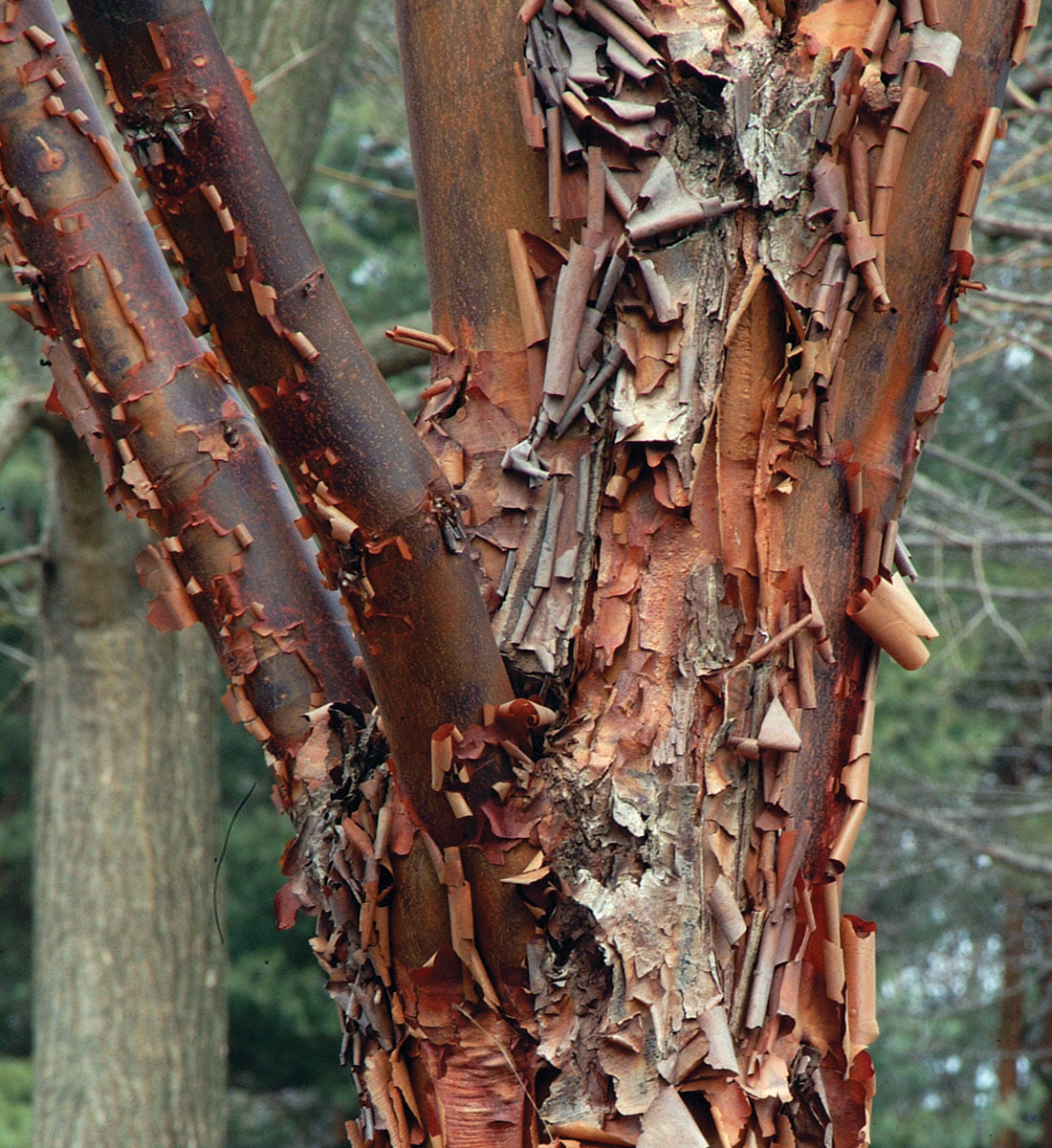
Name: Acer griseum
Zones: 4–8
Size: 20 to 30 feet tall and 15 to 25 feet wide
Conditions: Full sun to partial shade; average, well-drained soil
Native range: Central and eastern China
The four-season beauty of this lovely, small tree makes it a worthwhile choice for compact spaces in a garden or as a specimen in its own right. In winter, its best-known feature of coppery exfoliating bark contrasts with the cold-season landscape and offers an opportunity to admire the architectural upright structure of its branches. When spring comes, delicate, trifoliate, burgundy-tinged leaves emerge along with chartreuse flowers that are not particularly showy but nonetheless charming. The foliage matures into a vibrant green canopy as the season progresses and then turns vivid shades of red and orange as weather cools. As an added bonus, this tree is known for being pest-free and easy to care for, preferring medium moisture and average to slightly acidic soil.
‘Silver and Gold’ Yellow Twig Dogwood
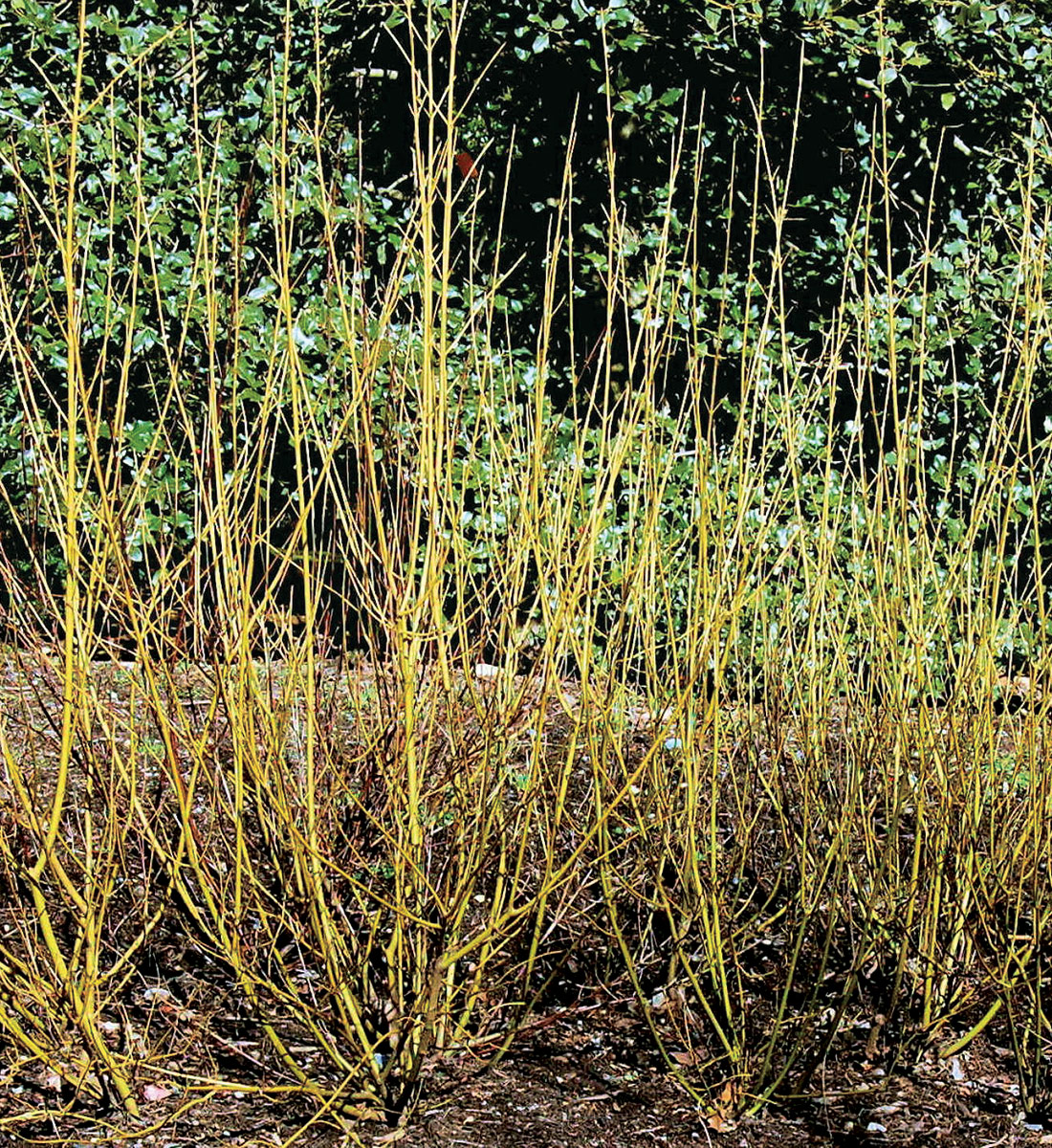
Name: Cornus sericea ‘Silver and Gold’
Zones: 3–8
Size: 5 to 7 feet tall and 6 to 8 feet wide
Conditions: Full sun to partial shade; rich, medium to wet soil
Native range: North America
‘Silver and Gold’ yellow twig dogwood is often grown either for its summertime display of green-and-white variegated foliage or for its bold yellow stems that add a pop of color in winter. However, this plant has much more to offer, with golden fall leaves and delicate white flowers in spring. To get the best winter color, prune out a quarter of the plant’s oldest stems each year, since new growth comes in with more intense coloring. For a stunning combination, plant it alongside little bluestem (Schizachyrium scoparium, Zones 3–9) and sweet fern (Comptonia peregrina, Zones 2–6). It can also be a great choice for a hedge and tolerates many types of soil, although it does best in one that is nutrient rich.
Cinnamon Fern
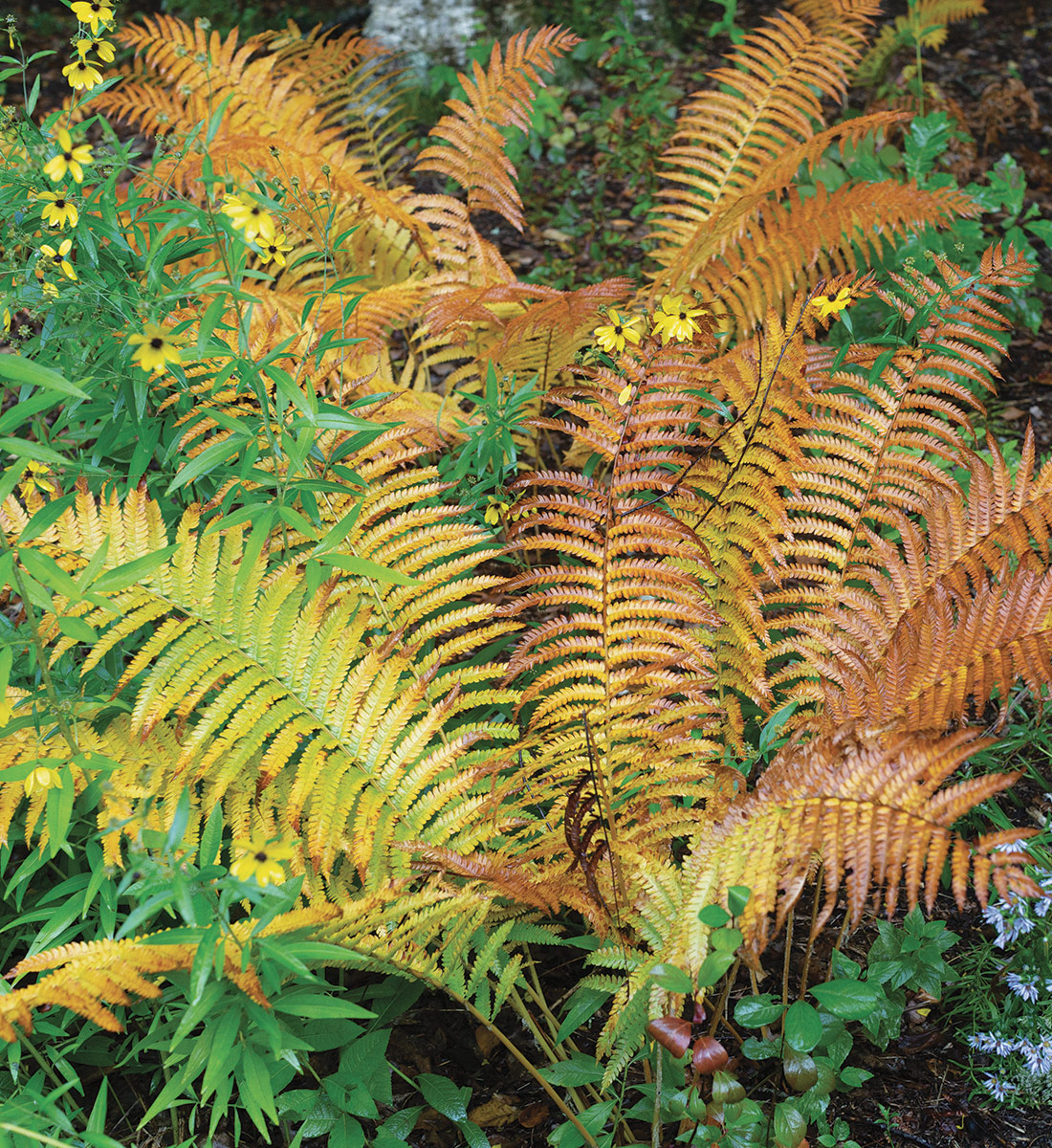
Name: Osmundastrum cinnamomeum
Zones: 3–9
Size: 3 to 6 feet tall and wide and 2 to 3 feet wide
Conditions: Partial to full shade; rich, medium to wet soil
Native range: North America, South America, and eastern Asia
Cinnamon fern is deciduous, but still has something to offer all year round. In spring, unfurling fiddleheads create unusual shapes that provide ephemeral excitement before taking their final form as vivid green, pinnately compound sterile fronds. This creates a striking contrast with the newly emerged cinnamon-orange fertile fronds. These later turn brown and stick around through winter, adding texture after the foliage has faded. This perennial’s lush green foliage turns golden and bronze in autumn (pictured). While generally low-maintenance, it does need consistent moisture. Rarely exceeding 3 feet tall, this fern may double that size in perfect conditions.
‘Northwind’ Switchgrass
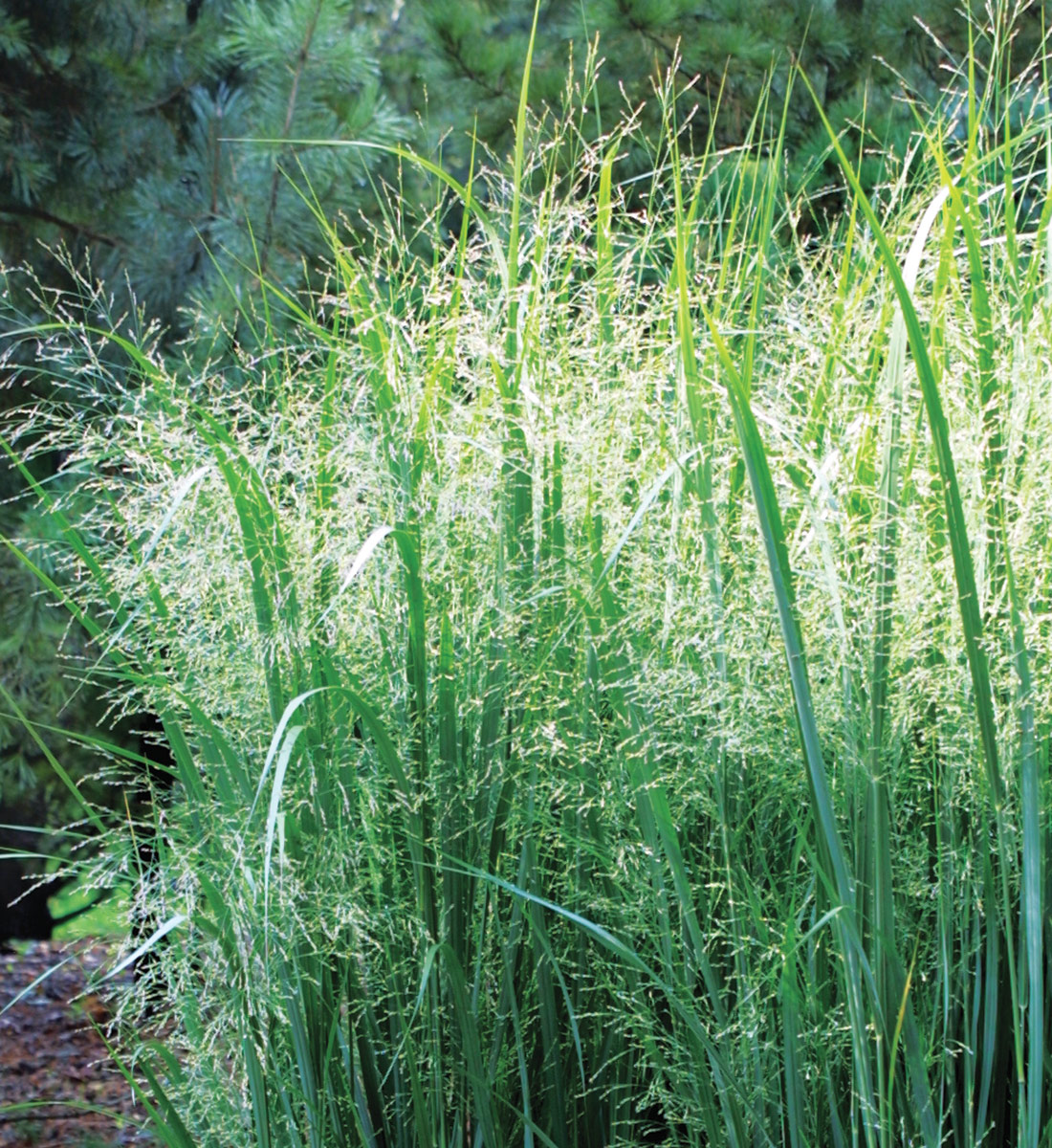
Name: Panicum virgatum ‘Northwind’
Zones: 5–9
Size: 4 to 6 feet tall and 2 to 3 feet wide
Conditions: Full sun to partial shade; well-drained soil
Native range: North America
‘Northwind’ is a durable, upright nativar of switchgrass, qualities that make it a great choice when looking for a grass with four-season interest. Newly emerging teal foliage provides a strong vertical element from the start. Summer follows with an attractive cloud of airy, greenish-white flowers. As autumn sets in, seed heads develop and the foliage turns a lovely yellow beige. Its sturdy habit allows it to stand tall throughout winter, providing structure and texture. The only maintenance this plant needs is a cutback in spring. Other benefits include a lack of major pest and disease issues and drought tolerance.
Regional expert: Laura Sweeney is a horticulturist who has worked in public gardens, urban farming, and retail nurseries. She currently manages a historic garden in Maryland and is the Mid-Atlantic forum moderator for FineGardening.com.
Northeast
Beetleweed
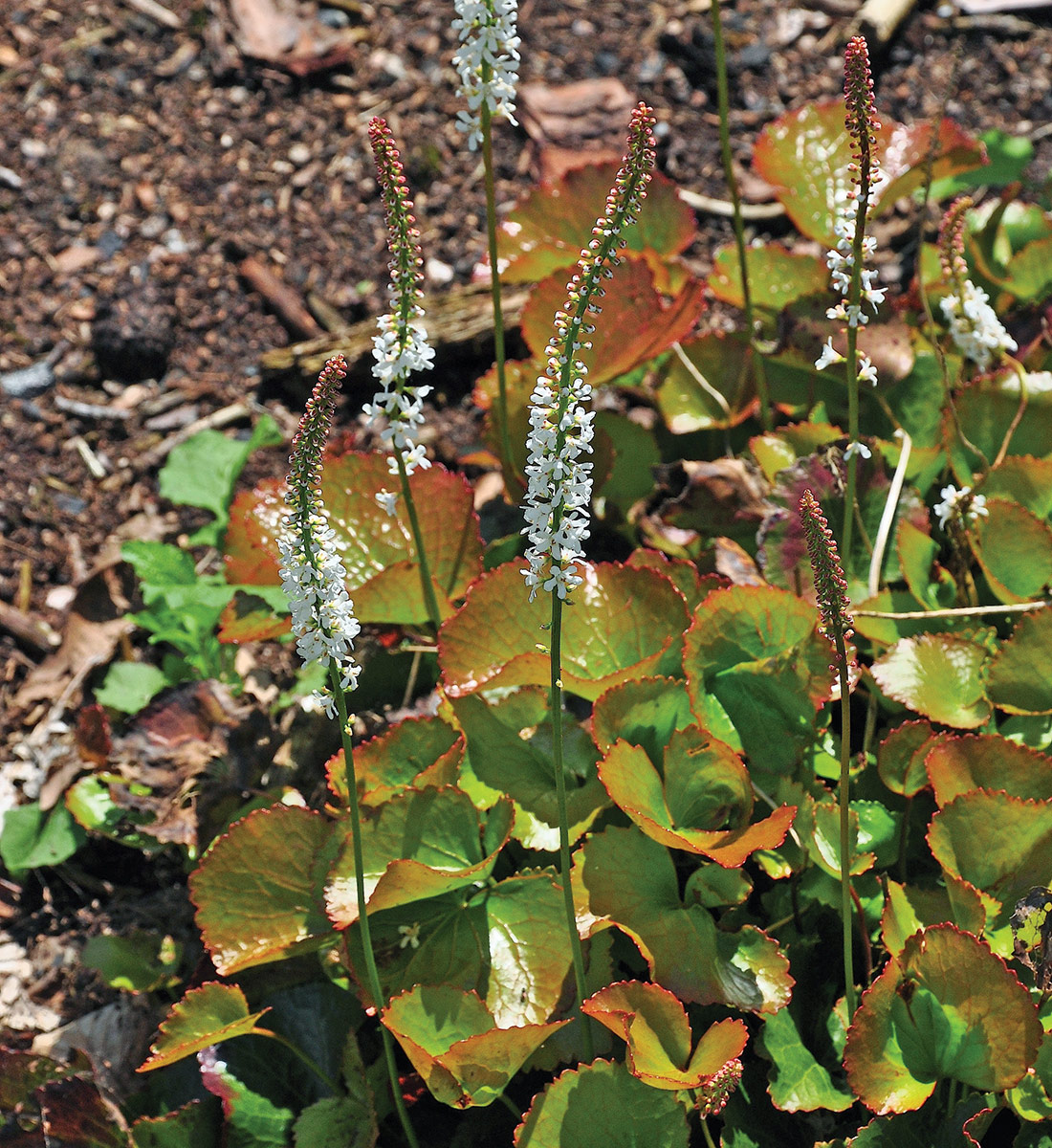
Name: Galax urceolata
Zones: 5–8
Size: 6 to 12 inches tall and 12 to 36 inches wide
Conditions: Partial to full shade; acidic, well-drained soil
Native range: Southeastern United States
Beetleweed is an appealing ground cover with lily pad–shaped leaves. It lends interest to the shade garden with its evergreen, glossy, and delicately crenulated foliage, along with wands of white spring flowers that can be as tall as 18 inches. Winter is its best season, when the dark green leaves turn burgundy red, especially with moderate sun exposure. Plant it alongside other acid-loving plants like wintergreen (Gaultheria procumbens, Zones 3–9) and Christmas fern (Polystichum acrostichoides, Zones 3–9) for a native evergreen winter tableau. Beetleweed also makes a long-lasting cut green, but since it can be slow to establish, it might be a while before you can comfortably trim the leaves.
Box Huckleberry
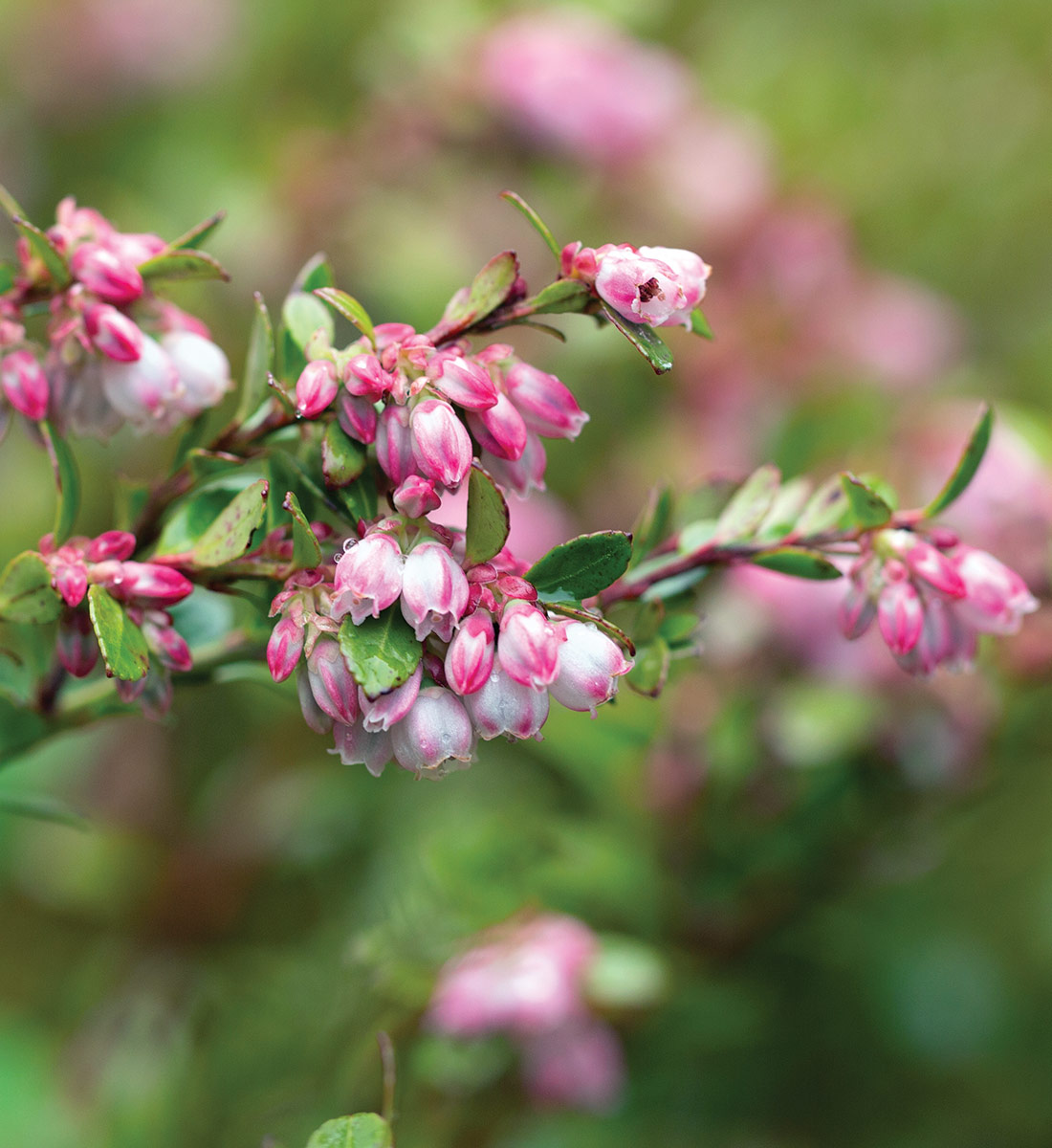
Name: Gaylussacia brachycera
Zones: 5–8
Size: 12 to 18 inches tall and spreading at least 3 feet wide
Conditions: Full sun to full shade; acidic, well-drained soil
Native range: Central eastern United States
You’ll plant a piece of botanical history when you add box huckleberry to your garden; a single colony of this shrub growing wild in Pennsylvania is thought to be around 13,000 years old, making it one of the oldest living plants on Earth. Your personal patch may not reach that fantastic age, but it’s still worth growing this clonally spreading creeper for its all-season appeal. In spring, white-pink flowers are followed by blue summer fruit. The glossy, boxwood-like foliage is evergreen and colors brilliantly in fall and winter. Box huckleberry is drought tolerant, preferring good drainage, high organic matter, and partial shade. Mulch it with chopped leaves to emulate its natural habitat.
Golden Caucasian Spruce
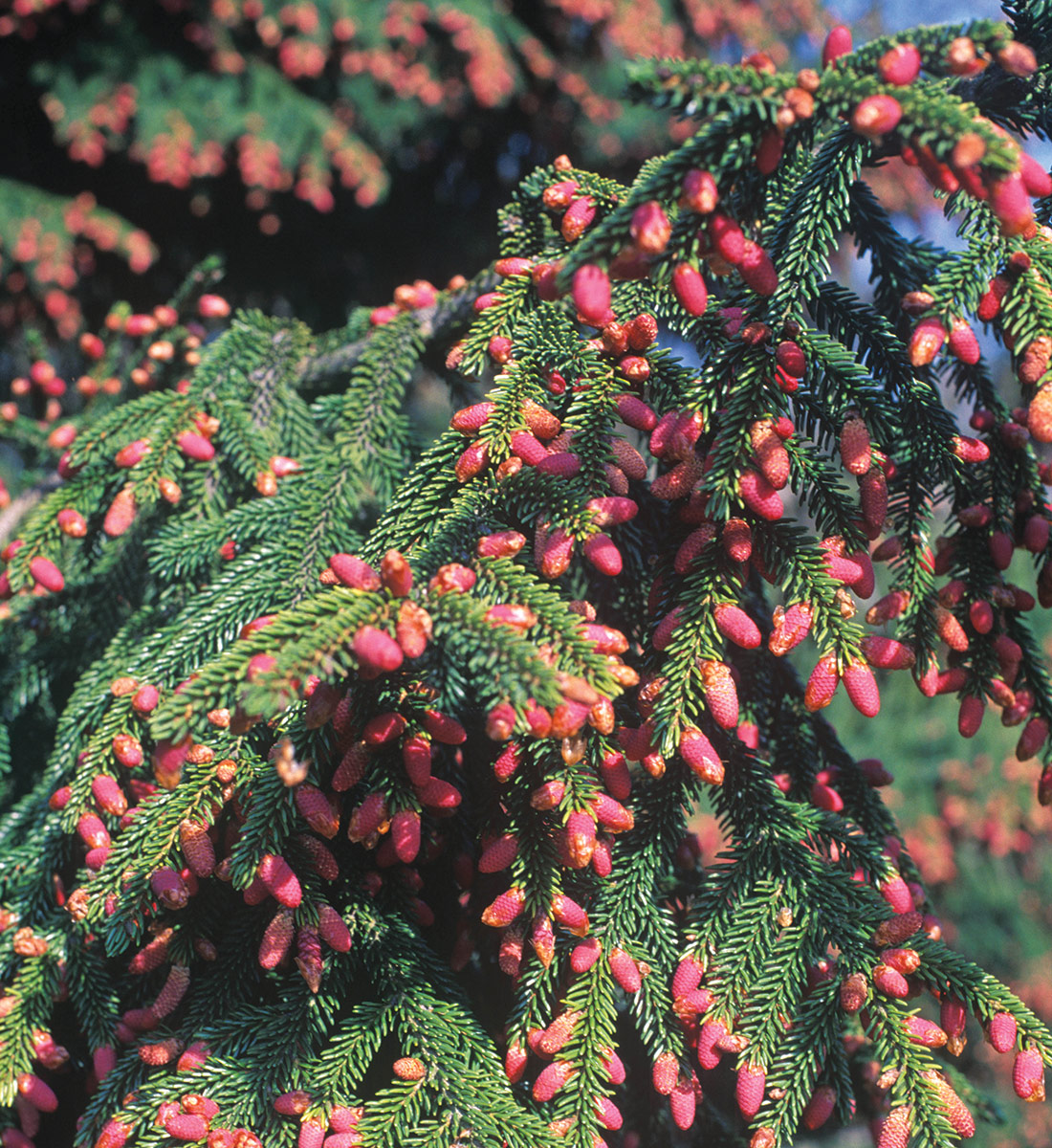
Name: Picea orientalis ‘Aurea’
Zones: 4–8
Size: 25 to 40 feet tall and 15 to 20 feet wide
Conditions: Full sun; well-drained soil
Native range: Caucasus region and northeast Turkey
I’ve had a plan to photograph this spruce every day for a year and make a little flip-book of its kaleidoscope of seasonal stages. Impossibly vibrant, buttery spring growth emerges from a winter of dark green, slender branches in traffic- stopping contrast. Attractive reddish cones develop as the season progresses, while the new chartreuse growth darkens to a deep green. The elegant and tidy habit, dense uniform needles, and stately stature of this tree make it a good fit for nearly any garden. Keep it well watered the first couple of seasons and give it a spot out of excessively wicked wind and this unfussy conifer will remain beautiful all winter. Caucasian spruce is susceptible to needle cast, so keep that in mind if the disease is prevalent in your area.
‘Lanham’s Purple’ Shining Sumac
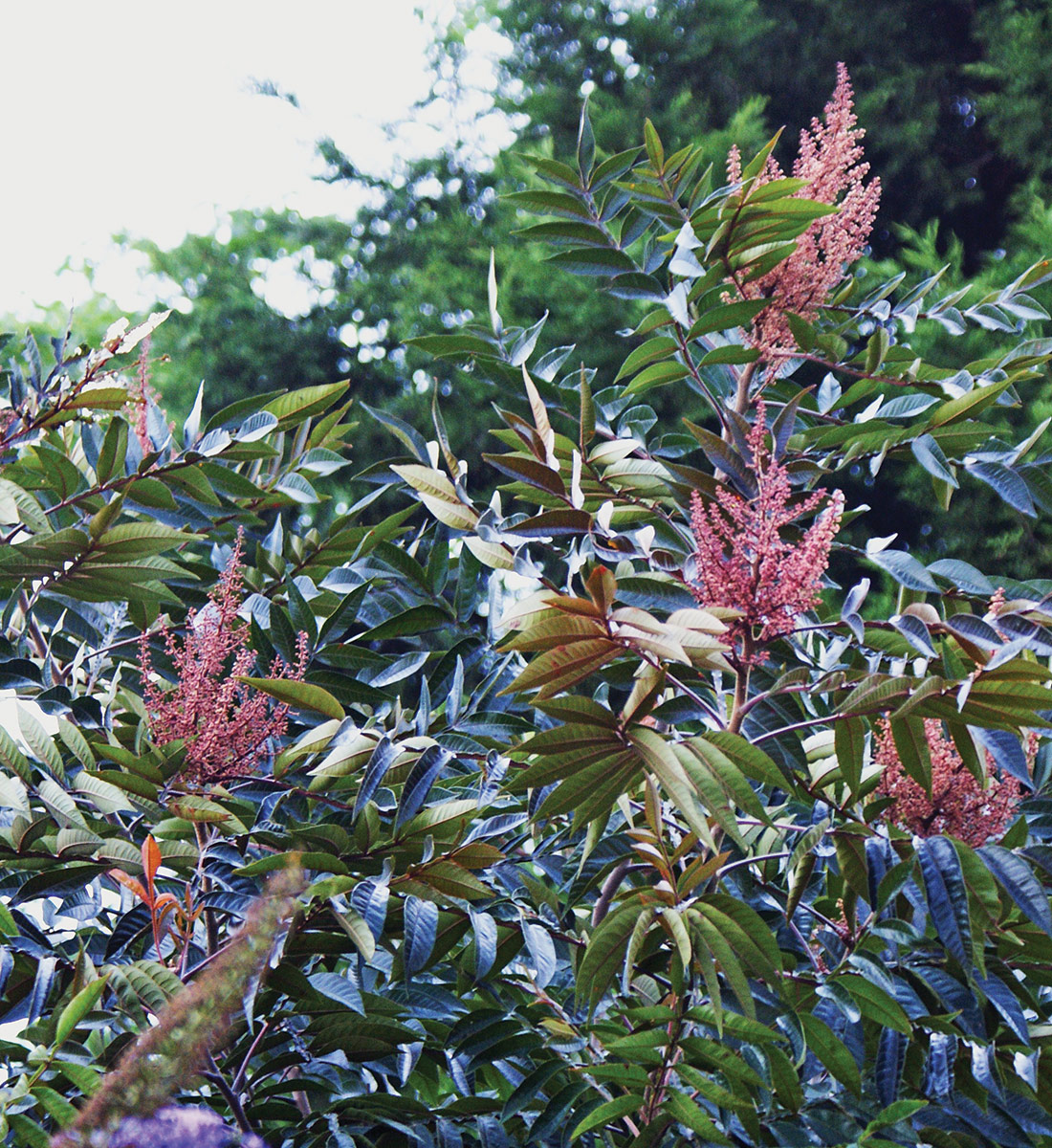
Name: Rhus copallinum ‘Lanham’s Purple’
Zones: 4–9
Size: 8 to 10 feet tall and wide
Conditions: Full sun; average to poor, well-drained soil
Native range: Central and eastern North America
With electric fall color, red fruit, and glossy, dark green leaves, the straight species of shining sumac is already a handsome native shrub, but ‘Lanham’s purple’ is next level. Purple spring growth evens out to a dark burgundy green, while subsequent new leaves come in varying shades for pleasing contrast all summer long. Shining sumac is a champion of fall, and this selection is superior to the species, mixing purple with shades of red and orange. Winter-persistent, red-brown seed heads finish out the show. Prune out older stems to maintain a fresher, more uniform appearance; otherwise, this is a low-maintenance plant with great four-season rewards.
Regional expert: Chloë Bowers has worked as a gardener and landscape designer on private estates for 20 years. She lives and gardens in Newtown, CT, and is also a Northeast regional reporter and forum moderator for FineGardening.com.
Regional expert photos: courtesy of the contributors.
Fine Gardening Recommended Products

ARS Telescoping Long Reach Pruner
Fine Gardening receives a commission for items purchased through links on this site, including Amazon Associates and other affiliate advertising programs.
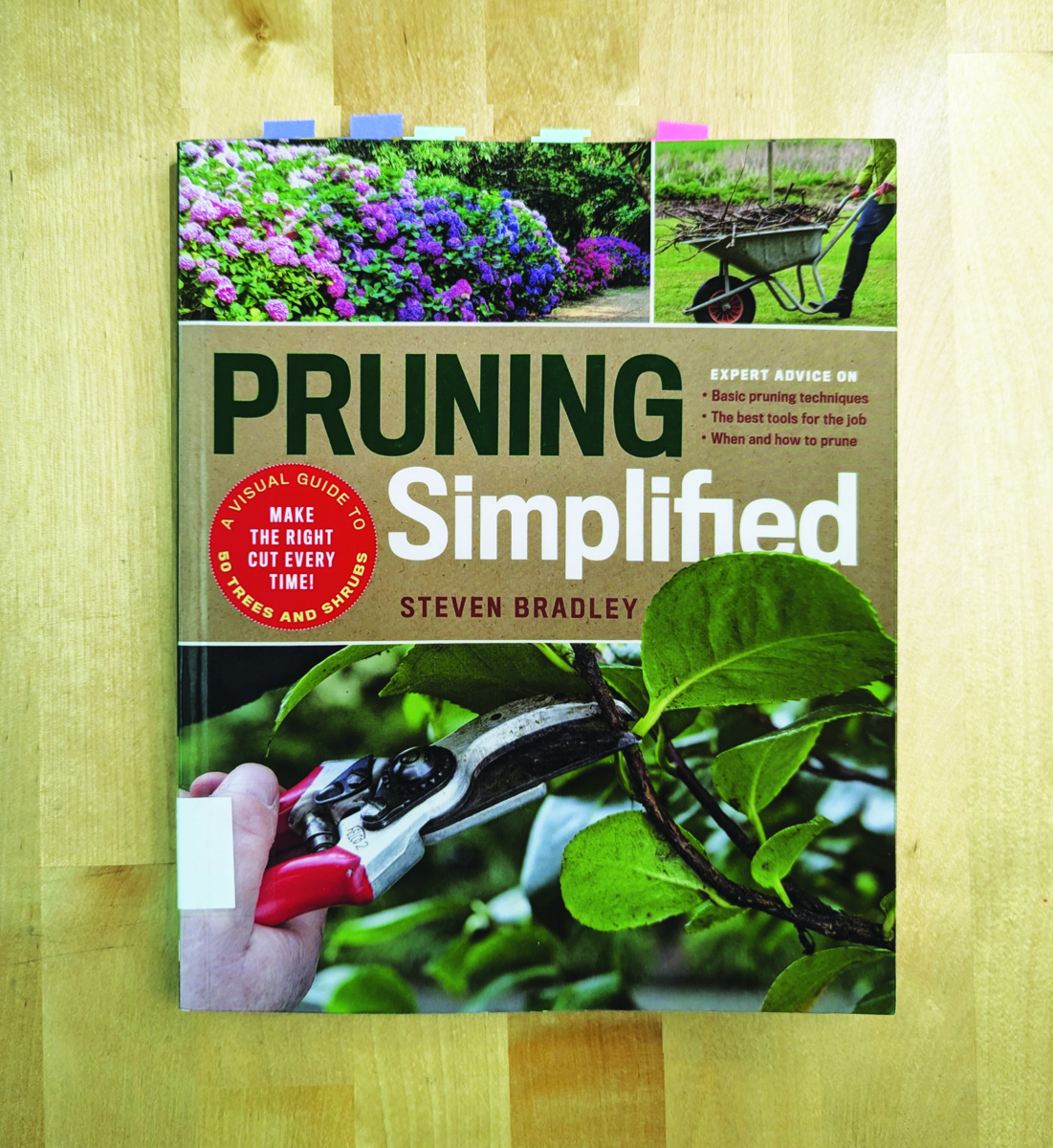
Pruning Simplified: A Step-by-Step Guide to 50 Popular Trees and Shrubs
Fine Gardening receives a commission for items purchased through links on this site, including Amazon Associates and other affiliate advertising programs.

DeWalt Variable-Speed Cordless Reciprocating Saw
Fine Gardening receives a commission for items purchased through links on this site, including Amazon Associates and other affiliate advertising programs.
- 18.31 x 6.13 x 4 inches
- 1-1/8-inch stroke length
- Variable speed trigger with 0-3000 spm










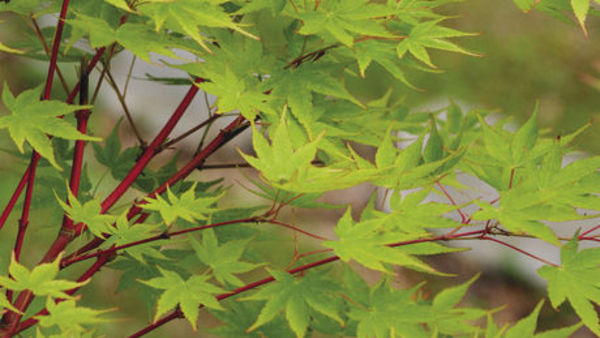
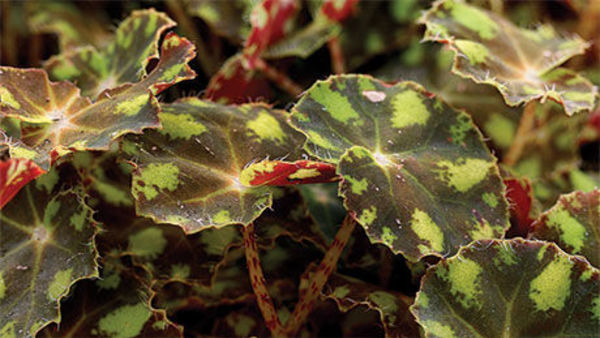
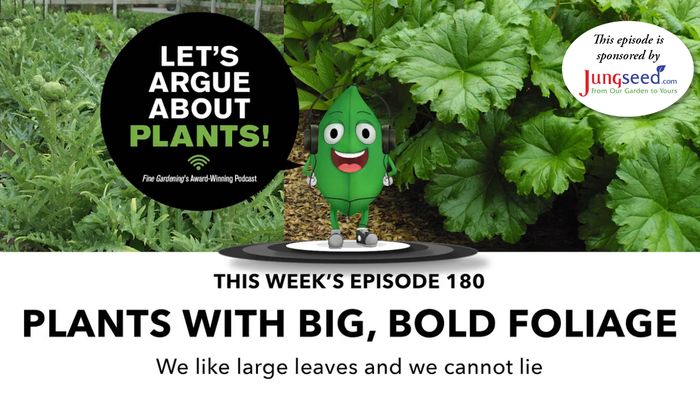
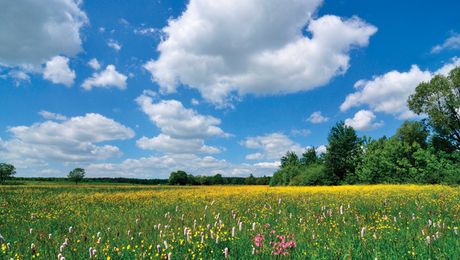
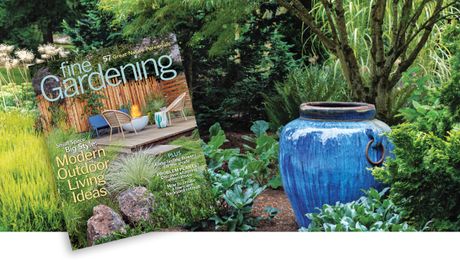










Comments
Log in or create an account to post a comment.
Sign up Log in